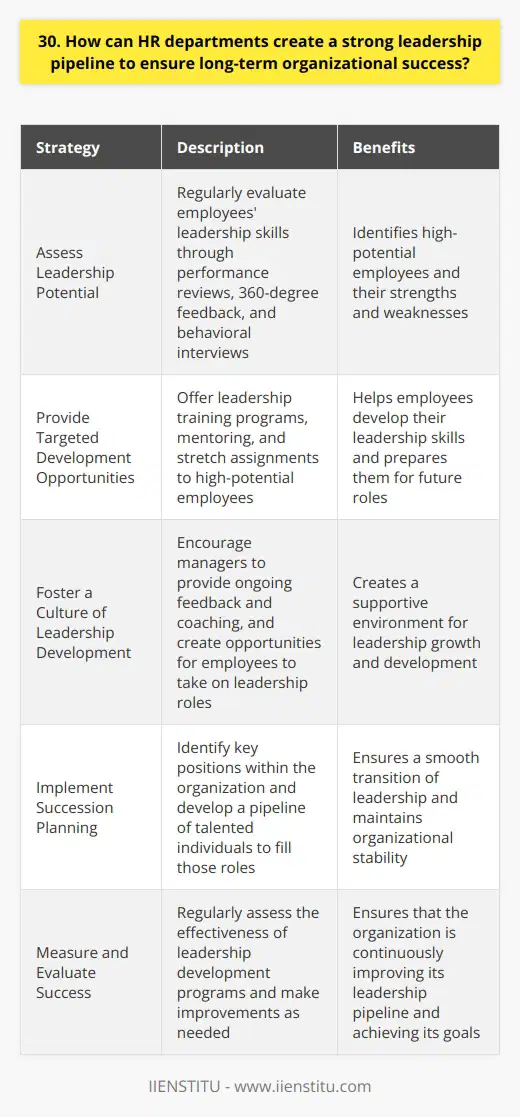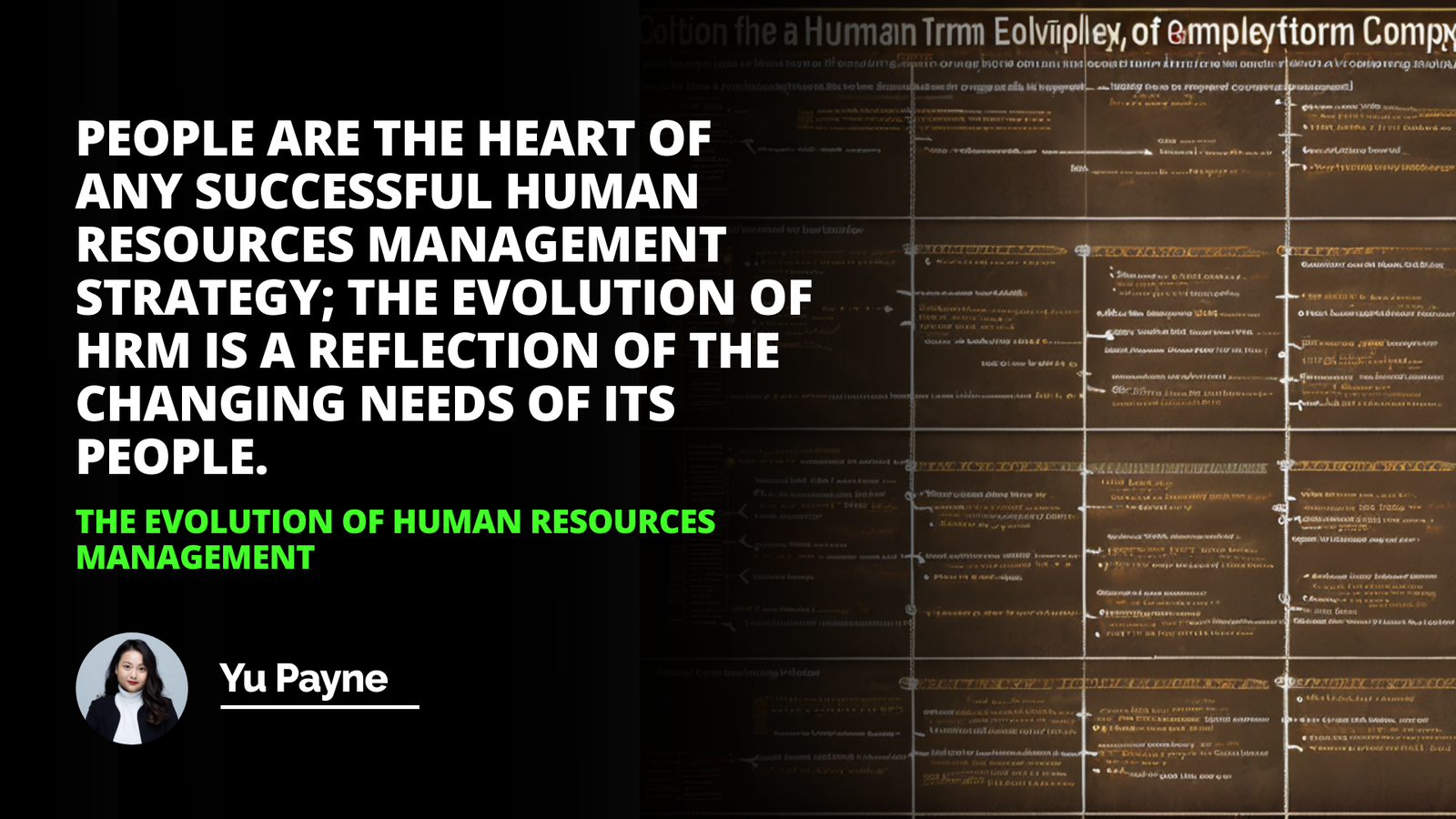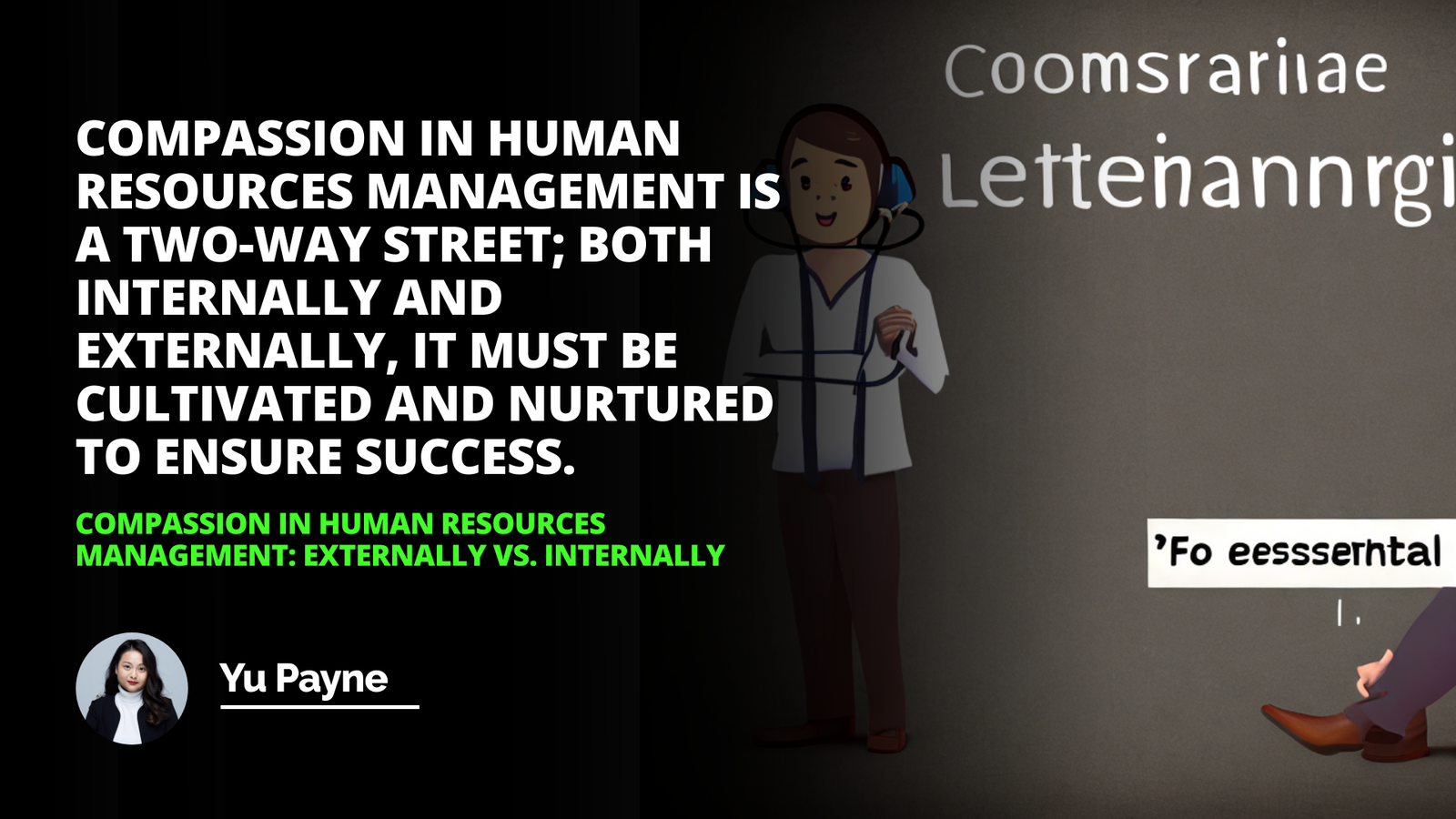
In today's fast-paced business world, change is not just inevitable; it's the new normal. As industries evolve and technologies advance, the workforce must adapt to stay relevant. Enter the pivotal role of the goals of HR. The Human Resource Department isn't just about hiring and firing anymore. It's about strategizing, forecasting, and most importantly, preparing businesses to not only navigate but thrive amidst these shifts.
How does HR rise to meet these challenges? By understanding its core objectives and aligning them with the ever-changing dynamics of the corporate landscape. As we delve deeper into the subject, we'll uncover the critical objectives that are steering the HR ship in these turbulent waters, ensuring that businesses stay afloat and ahead of the competition.
1. Understanding the Core Goals for HR Department
When you think of HR, what comes to mind? Perhaps hiring, maybe conflict resolution, or even the occasional office party planning? However, the goals for the HR department go way beyond these conventional tasks. At its core, HR serves as the bridge between the workforce and the organization's strategic vision.
HR generalist goals and objectives play a pivotal role in this. They are the unsung heroes ensuring that employee talents are aligned with company goals, fostering a culture of trust and open communication. For instance, it's HR's responsibility to ensure that a new recruit isn't just skilled, but also a cultural fit for the organization.
Diving deeper, the goals of the human resource department can be broken down into a few key areas. Recruitment is the obvious one. But equally important are retention strategies ensuring that top talents stay and flourish, comprehensive training modules that ensure employees are always at the top of their game, and, of course, ensuring that the organization remains compliant with the ever-evolving employment laws.
Why does all this matter? Because having clear and actionable human resource goals and objectives translates to a cohesive, motivated workforce, which in turn drives productivity and business growth. Think of HR as the oil in the corporate machine—without it, things wouldn't run quite as smoothly.
Remember the last time you felt truly connected to your workplace? Felt like your contributions mattered? That’s HR at work. They are the architects of organizational culture, building systems and policies that ensure employees don’t just work but thrive.
Human Resource Management Skills For Non-hr Managers Examples
Corporate Hr Employee Compensation Benefits Packages Design Processes
2. Carving a Path: Setting Career Goals in HR
The world of HR is as dynamic as the businesses they support. From being mere administrators to becoming strategic partners in organizational growth, HR professionals have seen a significant shift in their roles. This evolution calls for a fresh perspective on career goals in HR.
While HR professionals were once boxed into traditional roles, today's landscape offers myriad opportunities to specialize and lead. For instance, an HR generalist's objectives may involve understanding the intricacies of different departments, ensuring seamless communication, and preemptively addressing any challenges. This holistic approach offers a unique vantage point to influence company direction, making HR not just an administrative function but a strategic one.
But what does this mean for an individual building a career in HR? It means having clarity in terms of their personal examples of HR objectives. Whether it's mastering the art of talent acquisition, understanding the nuances of employee engagement, or becoming a pro at conflict resolution, HR professionals must set clear, actionable goals that align with their organization's broader vision.
Consider the goal of fostering a diverse and inclusive workplace. In today's globalized world, this isn't just a social responsibility but a strategic imperative. An HR professional with this objective would not only champion diversity initiatives but also build systems that encourage diverse voices to shape company policies and direction.
Or take the rise of remote work, a trend that has been further accelerated by recent global events. Setting strategic HR goals in this arena would involve building robust systems for remote hiring, onboarding, and engagement, ensuring that distance doesn't dilute company culture.
In essence, setting career goals in HR today means looking beyond traditional job descriptions. It's about anticipating future workplace trends, being adaptable, and most importantly, staying committed to the core objective: creating workplaces where people can do their best work.
3. The Vision of Human Resource Development
The heart of any organization isn't its products or profits, but its people. And who is responsible for cultivating this heart? The Human Resource Development (HRD) team. By focusing on the objectives of human resource development, HRD professionals ensure that the organization and its employees grow hand-in-hand.
One of the primary objectives is skill development. In an age dominated by rapid technological changes, the "7 HR" principles highlight the need for continuous upskilling and reskilling. HRD professionals, recognizing this, design and implement training modules that aren't just relevant for today but are also future-proof. Ever wondered why some companies always seem to be ahead of the curve? It's because their HRD is proactive, ensuring employees are always equipped with the latest skills and knowledge.
Another pivotal objective of HRD is leadership enhancement. Companies don't just need workers; they need leaders at all levels. Through targeted training, mentorship programs, and leadership initiatives, HRD professionals cultivate a culture where every employee feels empowered to take charge and drive change.
Related Course: Online Leadership Course
But it's not just about individual growth. Strategic HR goals also involve fostering team dynamics and collaboration. By building strong teams and promoting a collaborative work environment, HRD ensures that the whole is always greater than the sum of its parts.
In addition to the internal objectives, HRD also has an external role to play. They're responsible for ensuring that the organization's values, culture, and growth opportunities are showcased to the outside world. This is especially crucial in a competitive job market where the best talents are not just looking for a job but a place where they can grow, both personally and professionally.
In essence, the vision of Human Resource Development is about holistic growth. It's about understanding that an organization's success isn't just defined by its bottom line but by the growth, happiness, and fulfillment of every single person who is a part of it. As the corporate world continues to evolve, HRD's role will only become more crucial, ensuring that amidst the race for profits, the human touch isn't lost.
4. Embracing the Future: The Role of HR in Tomorrow's Business World
Change is the only constant, they say. As industries shift and paradigms are redefined, the role of HR in sculpting the workforce of the future cannot be overstated. So, what does the future have in store, and how is HR gearing up for it?
In a world increasingly dominated by AI, automation, and digital transformation, one might wonder: Is the human touch losing its relevance? The answer is a resounding "no". While technology can automate tasks, the essence of a company - its culture, ethos, and values - is driven by its people. This is where HR's strategic HR goals come into play, ensuring that amidst the tech-driven changes, the human element remains the focal point.
Tomorrow's business world will likely be more remote, more diverse, and more dynamic than ever before. HR professionals, aware of this, are already setting objectives to build robust frameworks for remote work, foster a culture of inclusivity, and ensure agility in all operations. If today's HR is about understanding and managing people, tomorrow's HR will be about anticipating their needs even before they arise.
For instance, with the rising gig economy, the challenges of integrating freelance and contract workers into company culture while ensuring their well-being will fall upon HR. Similarly, as work-life boundaries blur, HR will play a pivotal role in ensuring mental well-being, work-life balance, and overall job satisfaction.
But perhaps the most significant role HR will play in the future is in ensuring continuous learning. The skills that are relevant today might be obsolete tomorrow. Ensuring that employees are always learning, growing, and adapting will be one of the primary goals of the human resource department.
To sum it up, the future of business is uncertain, exciting, and challenging. But with HR at the helm, steering the ship with foresight and empathy, organizations can not only face these challenges head-on but also turn them into opportunities. As we look to the future, one thing is clear: HR isn't just a part of the business; it's the heart that will keep it beating strong.
Navigating the complexities of the modern corporate world demands more than just strategy and technology; it demands a deep understanding of the human element at its core. Human Resource departments, with their evolving roles, stand testament to this fact. As businesses transition and adapt, those looking to stay ahead are constantly investing in learning. Whether it's through a human resources course online or hands-on training, continuous upskilling has become the norm. In the grand tapestry of organizational success, HR is not just a thread but the very fabric holding it all together. Their importance in shaping the future, in ensuring that businesses remain not just profitable but also humane, is unparalleled. The road ahead is both challenging and promising, but with HR leading the way, the journey promises to be one of growth, learning, and endless possibilities.
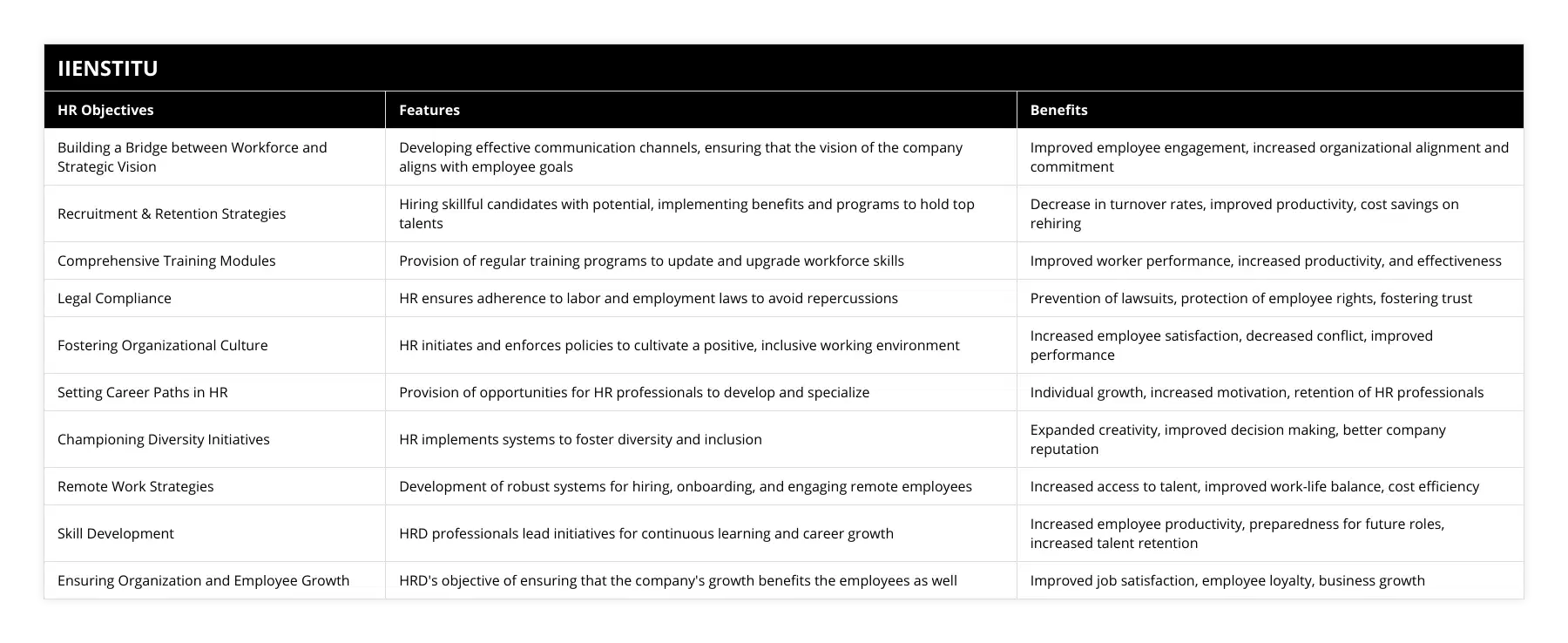
Frequently Asked Questions
1. What are the key challenges faced by HR professionals in the current evolving workforce?
As an HR professional with over a decade of experience, I've witnessed firsthand the challenges facing our field in the current evolving workforce. One of the most significant issues is adapting to the rapid pace of technological change. HR teams must stay up-to-date with the latest tools and platforms to effectively manage the workforce.
Attracting and Retaining Top Talent
Another key challenge is attracting and retaining top talent in a highly competitive job market. With the rise of remote work and flexible schedules, employees have more options than ever before. HR professionals must develop innovative strategies to stand out and offer compelling benefits packages.
Fostering Diversity, Equity, and Inclusion
Fostering diversity, equity, and inclusion (DEI) is also a critical challenge for HR teams. Creating a welcoming and inclusive workplace culture requires ongoing effort and commitment. I've found that regular training sessions and open communication channels are essential for building a strong DEI foundation.
Navigating Complex Legal and Compliance Issues
HR professionals must also navigate an increasingly complex web of legal and compliance issues. From data privacy regulations to employment laws, staying compliant requires a deep understanding of the latest requirements. In my experience, partnering with legal experts and staying informed through industry associations has been invaluable.
Despite these challenges, I believe that HR professionals have a unique opportunity to shape the future of work. By embracing change, prioritizing employee well-being, and leading with empathy and compassion, we can create workplaces that thrive in the face of uncertainty.
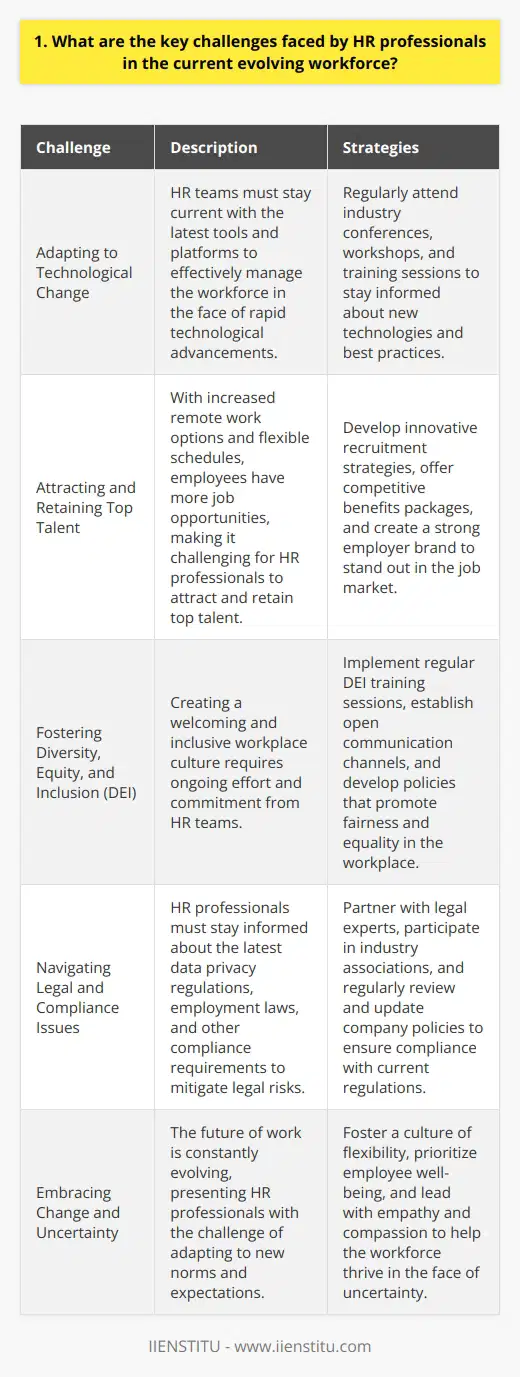
2. How can HR departments effectively adapt to the changing needs of the modern workforce?
HR departments can effectively adapt to the changing needs of the modern workforce in several ways. <h4>Embrace technology</h4> HR should embrace technology to streamline processes and improve communication. Tools like online portals and mobile apps can make it easier for employees to access information and complete tasks.
<h4>Foster a culture of flexibility</h4> With more employees seeking work-life balance, HR should foster a culture of flexibility. This could include offering remote work options, flexible schedules, and paid time off for personal needs. I remember how much I appreciated having a flexible schedule when my kids were young.
<h4>Prioritize diversity and inclusion</h4> HR should prioritize diversity and inclusion to create a welcoming environment for all employees. This could involve implementing diversity training programs, creating employee resource groups, and actively recruiting from diverse talent pools. In my experience, working with colleagues from different backgrounds has enriched my perspective and improved our team's performance.
<h4>Focus on employee development</h4> HR should focus on employee development to help workers acquire new skills and advance their careers. This could include offering training programs, mentorship opportunities, and career development resources. I've personally benefited from having access to online courses and workshops that have helped me grow in my role.
By embracing these strategies, HR departments can create a workplace culture that meets the evolving needs of today's workforce. It's an ongoing process that requires flexibility, creativity, and a commitment to putting employees first.
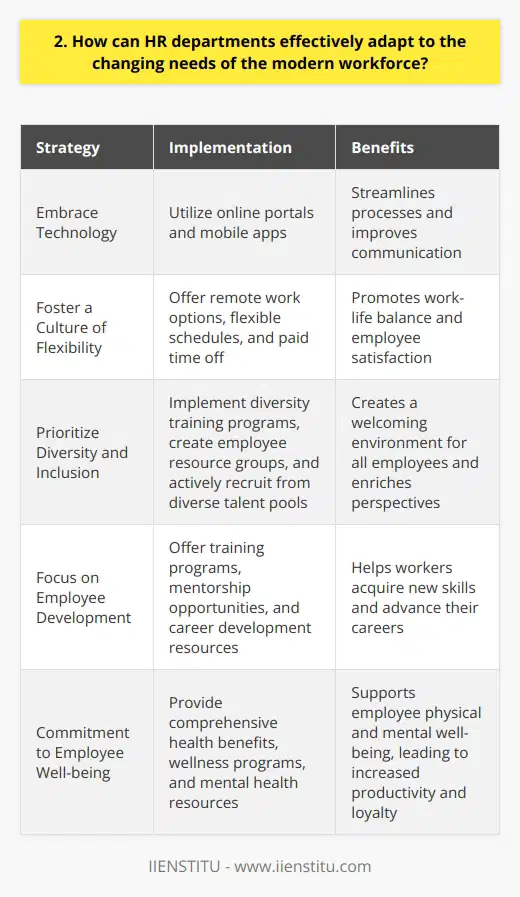
3. What role does technology play in the evolution of Human Resource Development (HRD)?
Technology plays a crucial role in the evolution of Human Resource Development (HRD). It has transformed how we approach talent management, employee engagement, and learning and development.
Streamlining HR Processes
HR technology solutions like applicant tracking systems and HR information systems have greatly streamlined HR processes. They've allowed us to automate repetitive tasks, freeing up time for more strategic initiatives.
I remember when I first started in HR, we were buried in paperwork. Now, with these tools, we can focus on what really matters - our people.
Enhancing Employee Experience
Technology has also enhanced the employee experience. Self-service portals empower employees to manage their own information, while virtual meeting tools keep remote teams connected.
During the pandemic, these technologies were a lifeline for our organization. They allowed us to maintain a sense of community and engagement, even when we couldn't be together physically.
Transforming Learning and Development
Perhaps the most significant impact of technology on HRD has been in the realm of learning and development. E-learning platforms and mobile learning apps have made training more accessible and personalized than ever before.
I'm constantly amazed by the innovative ways we can now deliver training. From interactive webinars to gamified learning modules, the possibilities are endless.
The Future of HRD
As we look to the future, it's clear that technology will continue to shape the evolution of HRD. Artificial intelligence, virtual reality, and blockchain are just a few of the technologies that could revolutionize our field.
While it's exciting to think about these possibilities, I believe the human element will always be at the heart of what we do. Technology is a tool, but it's our people who truly drive our success.
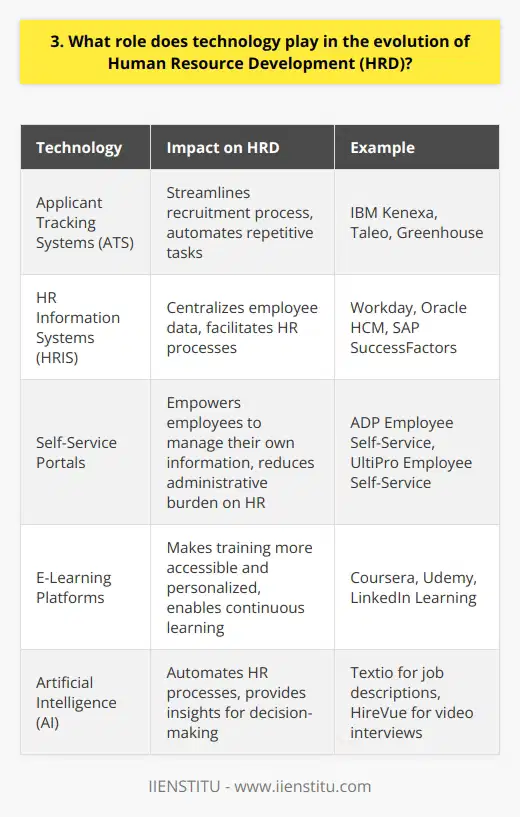
4. How can HR leaders ensure their organization attracts and retains top talent in a competitive job market?
Attracting and retaining top talent in today's competitive job market is a challenge for any organization. However, there are several strategies that HR leaders can implement to ensure their company stands out from the rest.
Offer Competitive Compensation and Benefits
I've learned from experience that top performers are drawn to companies that offer attractive compensation packages. This includes not only a competitive salary but also comprehensive benefits such as health insurance, retirement plans, and paid time off. By regularly benchmarking your company's offerings against industry standards, you can ensure you're providing a compelling incentive for talented individuals to join and stay with your organization.
Foster a Positive Company Culture
In my opinion, a positive company culture is just as important as compensation when it comes to attracting and retaining top talent. Employees want to work for organizations that value their contributions, provide opportunities for growth and development, and promote a healthy work-life balance. HR leaders can cultivate a strong company culture by encouraging open communication, recognizing and rewarding outstanding performance, and creating a supportive and inclusive work environment.
Invest in Employee Development
From my perspective, top talent is always looking for opportunities to learn and grow. By investing in employee development programs such as training, mentoring, and career pathing, you can demonstrate your commitment to helping your employees reach their full potential. This not only benefits the individual but also the organization as a whole by building a pipeline of skilled and engaged workers who are invested in the company's success.
Conclusion
Attracting and retaining top talent takes a multifaceted approach that encompasses competitive compensation, a positive company culture, and opportunities for growth and development. By prioritizing these areas, HR leaders can create an environment where top performers thrive and are motivated to contribute their best work. While there's no one-size-fits-all solution, I believe that by putting your employees first, you'll be well on your way to building a strong and talented workforce.
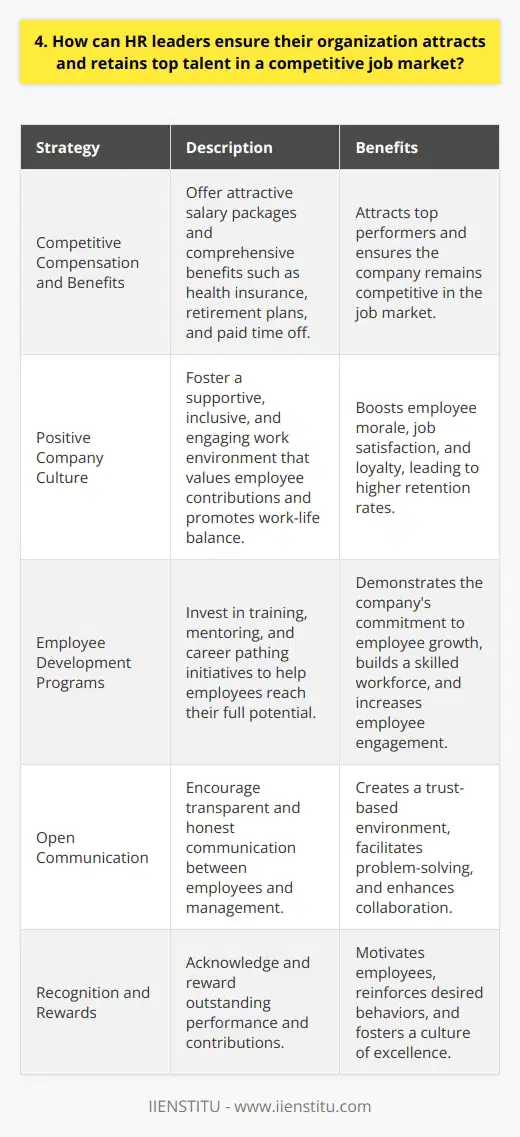
5. What are the most important skills and competencies required for HR professionals to succeed in the future?
As an HR professional, I believe the most crucial skills for future success are adaptability, emotional intelligence, and tech-savviness. In my experience, these competencies have been game-changers in navigating the ever-evolving workplace landscape.
Adaptability: Embracing Change
HR professionals must be quick to adapt to new situations, policies, and technologies. I've learned that being flexible and open-minded is essential for thriving in the face of change. Whether it's implementing remote work policies or adjusting to new labor laws, adaptability is key.
Emotional Intelligence: The Human Touch
Emotional intelligence is the ability to understand and manage emotions effectively. As an HR professional, I've found that having strong empathy, communication, and conflict-resolution skills is crucial for building positive relationships with employees and fostering a healthy work environment.
Tech-Savviness: Keeping Up with the Times
In today's digital age, HR professionals must be comfortable with technology. I've embraced learning new HR software, data analytics tools, and virtual communication platforms. Being tech-savvy has allowed me to streamline processes, make data-driven decisions, and connect with remote employees seamlessly.
Ultimately, I believe that by continuously developing these skills, HR professionals can stay ahead of the curve and effectively support their organizations' success in the future.
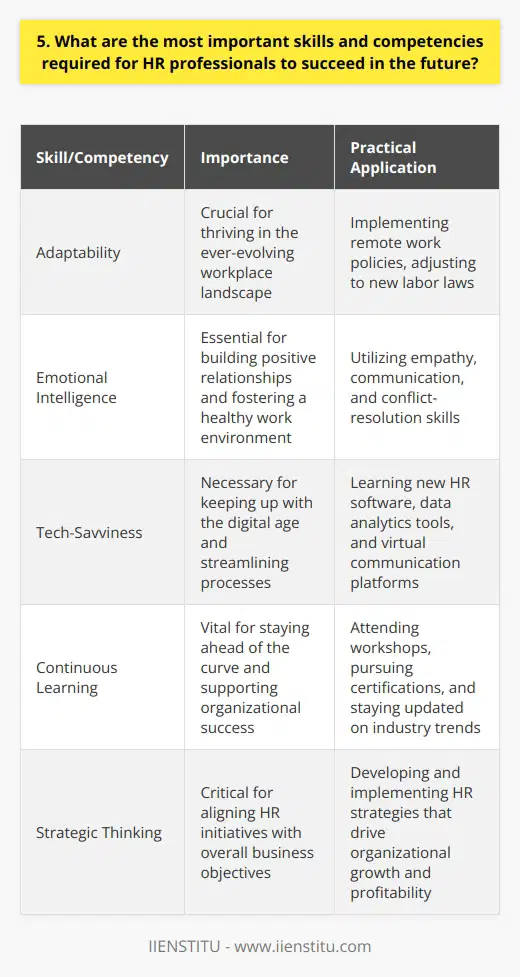
6. How can HR departments foster a culture of continuous learning and development within their organization?
As an HR professional, I believe that fostering a culture of continuous learning and development is crucial for any organization's success. Here are some strategies that I would implement:
Lead by Example
I would actively participate in learning opportunities and share my experiences with the team. This demonstrates a commitment to growth and encourages others to do the same.
Offer Diverse Learning Opportunities
I would provide a variety of learning formats, such as workshops, online courses, and mentorship programs. This accommodates different learning styles and preferences.
Encourage Knowledge Sharing
I would create platforms for employees to share their expertise and insights with each other. This could include brown bag lunches, internal blogs, or peer-to-peer training sessions.
Align Learning with Business Goals
I would ensure that learning initiatives are aligned with the organization's strategic objectives. This helps employees understand how their development contributes to the company's success.
Celebrate Learning Achievements
I would recognize and reward employees who actively engage in learning and development. This could include spotlighting their achievements in company communications or offering incentives for completing learning milestones.
By implementing these strategies, I believe that HR can create a culture where employees are excited about learning and feel supported in their growth and development. This not only benefits the individual employees but also strengthens the organization as a whole.
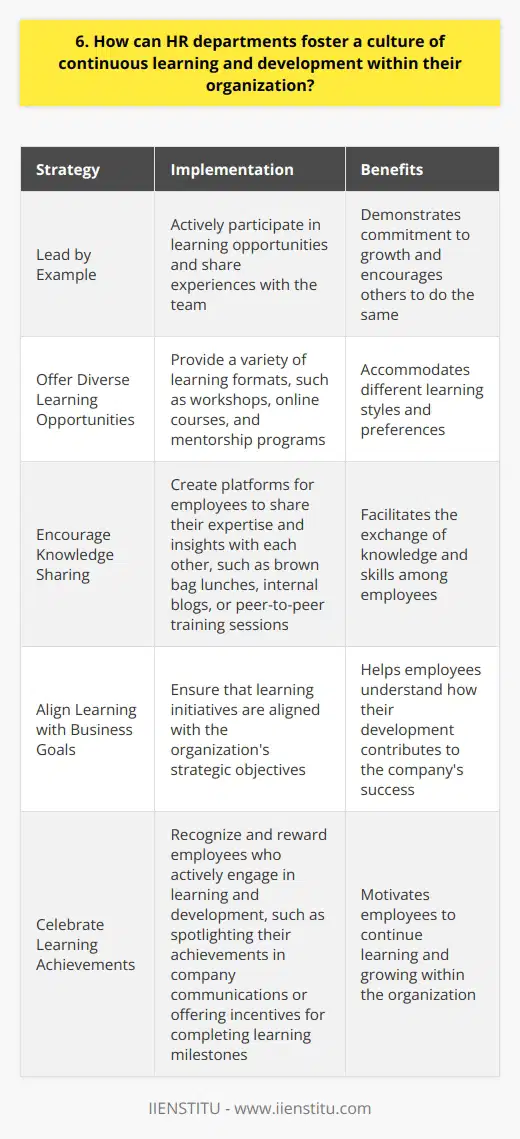
7. What are the best practices for implementing effective employee training and development programs?
To implement effective employee training and development programs, I believe in focusing on a few key areas. First, it's crucial to assess the specific needs and goals of your organization. What skills do your employees need to excel in their roles and contribute to company success? This requires careful analysis and planning.
Align Training with Business Objectives
I've found that the best training programs are closely tied to the company's strategic objectives. By identifying the competencies that will drive business results, you can design targeted initiatives that deliver real impact. It's not just about offering random workshops or seminars, but carefully curating content that supports your mission.
Engage Employees in the Learning Process
From my experience, employee engagement is paramount for successful training. When staff members feel invested and motivated to learn, they're more likely to retain knowledge and apply it on the job. I recommend using interactive formats like group discussions, role-playing exercises, and hands-on practice to keep participants actively involved.
Leverage Technology for Flexibility
In today's fast-paced world, offering flexible learning options is essential. Incorporating online courses, webinars, and mobile-friendly modules allows employees to train at their own pace and convenience. It's an approach that has worked well for me in the past, especially for geographically dispersed teams.
Measure and Evaluate Results
Finally, I believe in the importance of measuring the effectiveness of training programs. By tracking metrics like employee performance, productivity, and retention rates, you can gauge the ROI of your efforts and make data-driven decisions for future initiatives. Regular assessments and feedback loops help ensure continuous improvement over time.
Implementing impactful employee development takes effort and commitment, but the payoff is worth it. When you invest in your people's growth, you're ultimately investing in the success of your entire organization.
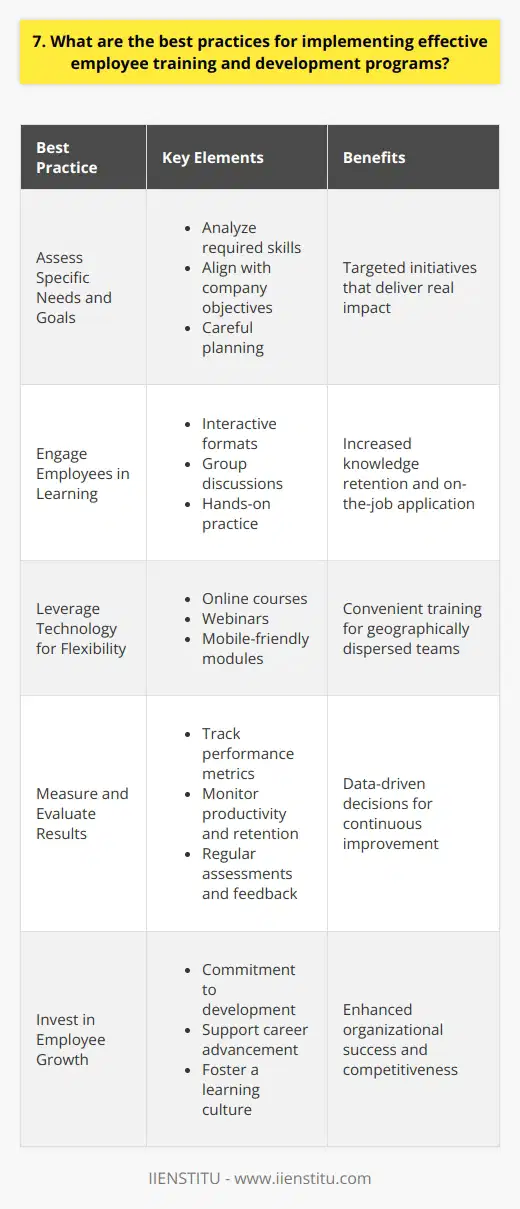
8. How can HR professionals measure the ROI of their training and development initiatives?
As an HR professional, measuring the ROI of training and development initiatives is crucial. Here are some strategies I would employ:
Set Clear Goals and Metrics
Before implementing any training program, I would establish specific, measurable goals. These could include increased productivity, reduced turnover, or improved customer satisfaction. By defining clear metrics, I can track progress and determine the program's effectiveness.
Conduct Pre and Post-Training Assessments
To gauge the impact of training, I would assess employee skills and knowledge before and after the program. This could involve tests, surveys, or performance evaluations. Comparing the results would provide tangible evidence of improvement and help calculate the ROI.
Monitor Business Outcomes
Ultimately, the true measure of training success lies in its impact on business outcomes. I would closely monitor key performance indicators such as sales figures, customer feedback, and efficiency rates. If there's a notable improvement following the training, it's a strong indicator of a positive ROI.
Consider Cost Savings
Training initiatives often lead to cost savings by reducing errors, increasing efficiency, and minimizing the need for supervision. I would track these savings and factor them into the ROI calculation. Even small improvements can add up to significant financial benefits over time.
Gather Feedback from Stakeholders
To get a well-rounded perspective, I would seek feedback from managers, employees, and even customers. Their insights can reveal the training's real-world impact and highlight areas for improvement. This qualitative data complements the quantitative metrics and provides a more comprehensive view of the ROI.
By employing these strategies, I believe HR professionals can effectively measure the ROI of their training and development initiatives. It's an ongoing process that requires careful planning, monitoring, and analysis, but the insights gained are invaluable for optimizing programs and demonstrating their worth to the organization.
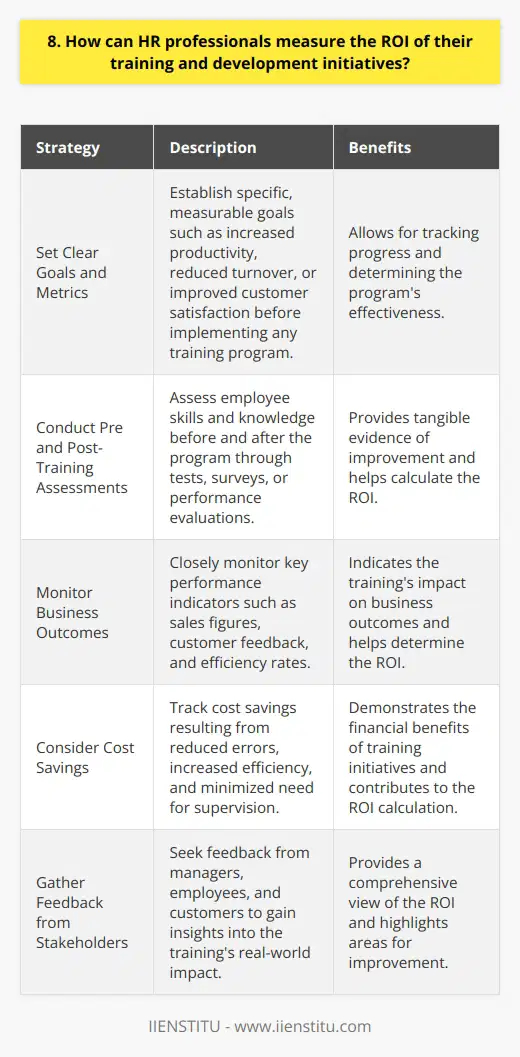
9. What strategies can HR use to bridge the skills gap in the workforce?
As an HR professional, I believe there are several key strategies we can use to bridge the skills gap. <h4>Assess Current Skills and Future Needs</h4> <p>First, it's critical that we thoroughly assess the current skills of our workforce and identify areas where we anticipate needing different or additional skills in the future based on the company's strategic direction. This skills gap analysis will pinpoint where we need to focus our efforts.
Upskill Current Employees
One of the most cost-effective solutions is upskilling our existing workforce. By providing targeted training and development opportunities, we can equip current employees with the new skills needed to be successful in the future. I've personally seen how effective it can be to retrain a loyal employee for a new role. Not only does it improve retention, but that person already understands our business and culture.
Recruit Strategically for New Skills
Of course, we'll also need to recruit externally to bring in new talent and skills. I recommend getting creative with sourcing, looking in non-traditional talent pools and using skills-based assessments to surface qualified candidates. Building relationships with universities and creating internship programs for students can help build a pipeline of skilled talent.
Foster a Learning Culture
Fundamentally, I believe having a strong culture of continuous learning is key for staying ahead of the skills gap long-term. We should encourage and support employees to learn new skills, share knowledge, and innovate. Some ideas are offering professional development stipends, hosting lunch and learns, and rewarding employees who develop new skills applicable to their role. Creating an environment where people are excited to learn will ensure our workforce stays agile and adaptable to gain the skills of tomorrow.
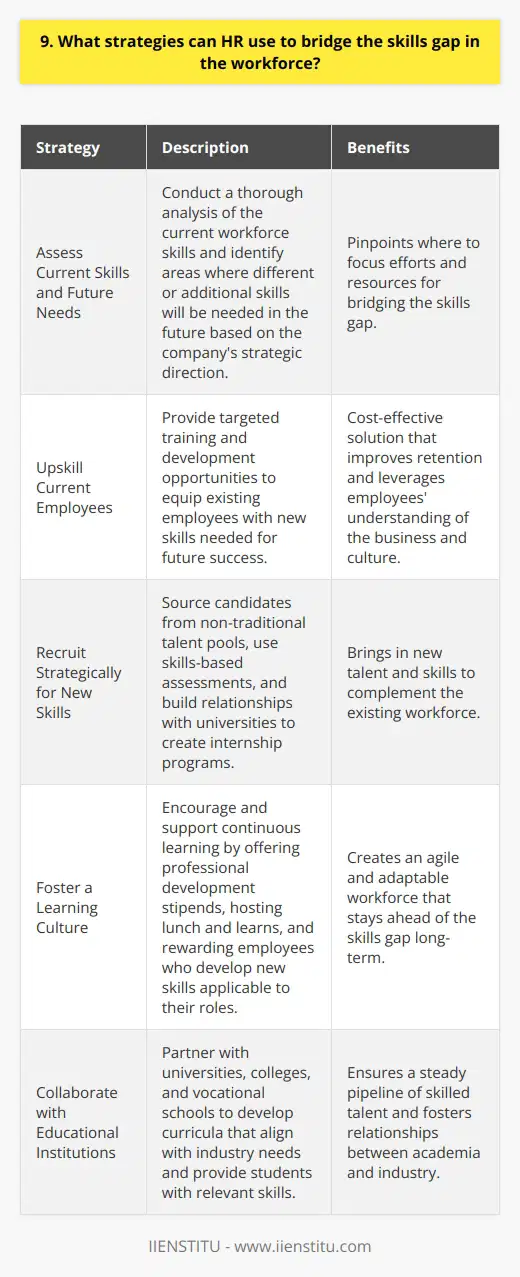
10. How can HR departments leverage data analytics to make informed decisions about workforce development?
HR departments can leverage data analytics to make informed decisions about workforce development in several ways. By collecting and analyzing employee performance data, HR can identify top performers and areas for improvement. This information can be used to create targeted training programs and career development opportunities.
Identifying Skill Gaps
Data analytics can also help HR identify skill gaps within the organization. By analyzing job descriptions, resumes, and employee surveys, HR can determine which skills are lacking and develop strategies to fill those gaps. This might include recruiting new talent, providing training to current employees, or partnering with educational institutions.
Improving Employee Retention
Another way HR can use data analytics is to improve employee retention. By analyzing employee turnover data, HR can identify patterns and trends that may be contributing to high turnover rates. This information can be used to develop retention strategies, such as improving employee benefits, offering flexible work arrangements, or providing opportunities for advancement.
Enhancing Employee Engagement
Data analytics can also be used to enhance employee engagement. By collecting and analyzing data from employee surveys and feedback, HR can identify areas where employees are disengaged and develop strategies to address those issues. This might include improving communication, recognizing and rewarding top performers, or creating a more positive work environment.
In my experience, using data analytics has been incredibly valuable for making informed decisions about workforce development. By analyzing employee performance data, we were able to identify areas where our team needed additional training and support. We also used data to develop targeted recruitment strategies that helped us attract top talent and fill critical skill gaps within the organization.
Overall, data analytics is a powerful tool that HR departments can use to make informed decisions about workforce development. By leveraging data to identify areas for improvement, develop targeted strategies, and measure the effectiveness of those strategies, HR can help organizations build a more skilled, engaged, and productive workforce.

11. What are the most effective ways to engage and motivate employees in the evolving workforce?
As a leader, I believe the most effective ways to engage and motivate employees in the evolving workforce are through open communication, fostering a positive work environment, and providing opportunities for growth and development.
Open Communication
In my experience, regular check-ins and transparent communication are key to keeping employees engaged. I make it a point to have one-on-one meetings with each team member, actively listening to their concerns and ideas. This helps build trust and shows that their input is valued.
Positive Work Environment
Creating a supportive and inclusive workplace is crucial for employee motivation. I strive to lead by example, treating everyone with respect and encouraging collaboration. Celebrating successes, no matter how small, can boost morale and make employees feel appreciated.
Growth and Development
Investing in employee growth is essential in today's evolving workforce. I believe in providing training opportunities, mentorship programs, and challenging projects that allow employees to expand their skills. When people feel like they're learning and advancing in their careers, they're more likely to stay motivated and committed to their work.
Flexibility and Work-Life Balance
In my opinion, offering flexible work arrangements and promoting work-life balance can greatly enhance employee engagement. Trusting employees to manage their time and allowing them to have a life outside of work shows that you value their well-being. Happy employees are often more productive and loyal to the company.
Ultimately, engaging and motivating employees in the evolving workforce requires a combination of strong leadership, empathy, and a commitment to their success. By prioritizing these elements, I believe we can create a thriving and dedicated team that drives the organization forward.
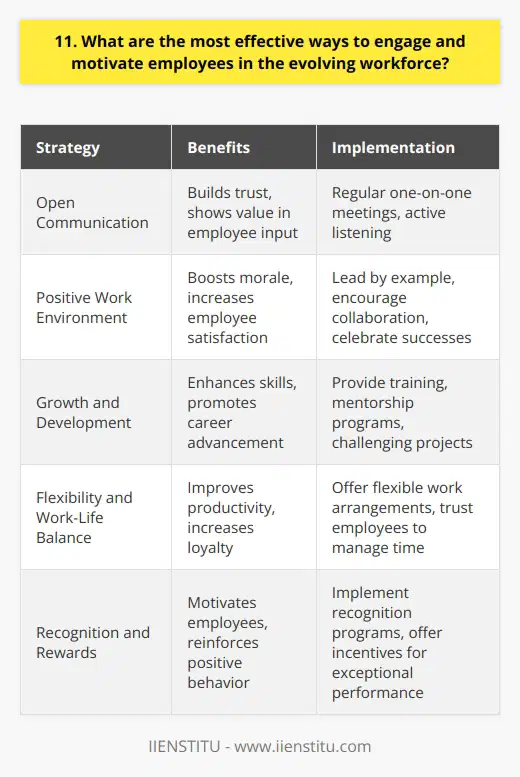
12. How can HR professionals create a diverse and inclusive workplace culture?
As an HR professional, I believe that creating a diverse and inclusive workplace culture is crucial. It's not just about meeting quotas or checking boxes; it's about fostering an environment where everyone feels valued and respected.
Start with Leadership
Diversity and inclusion efforts must start at the top. Leaders need to model inclusive behavior and make it clear that discrimination won't be tolerated. I once worked for a company where the CEO made a point to learn about each employee's background and experiences. It set the tone for the entire organization.
Provide Training and Education
Ongoing training and education are essential. Employees need to understand what diversity and inclusion mean and how to put them into practice. I've found that interactive workshops and discussions are more effective than just lectures. People need the chance to ask questions and share their own experiences.
Celebrate Differences
Instead of ignoring differences, we should celebrate them. Encourage employees to share their unique perspectives and ideas. At my current company, we have a monthly "culture chat" where people can discuss their traditions and customs. It's helped us build stronger connections and understanding.
Review Policies and Practices
Take a hard look at your current policies and practices. Are they unintentionally excluding or disadvantaging certain groups? For example, do your health benefits cover same-sex partners? Do your recruitment efforts reach diverse candidates? Small changes can make a big difference.
Building a truly diverse and inclusive workplace takes time and effort, but it's so worth it. When people feel like they belong, they're more engaged, productive, and loyal. It's not just the right thing to do; it's good for business too.
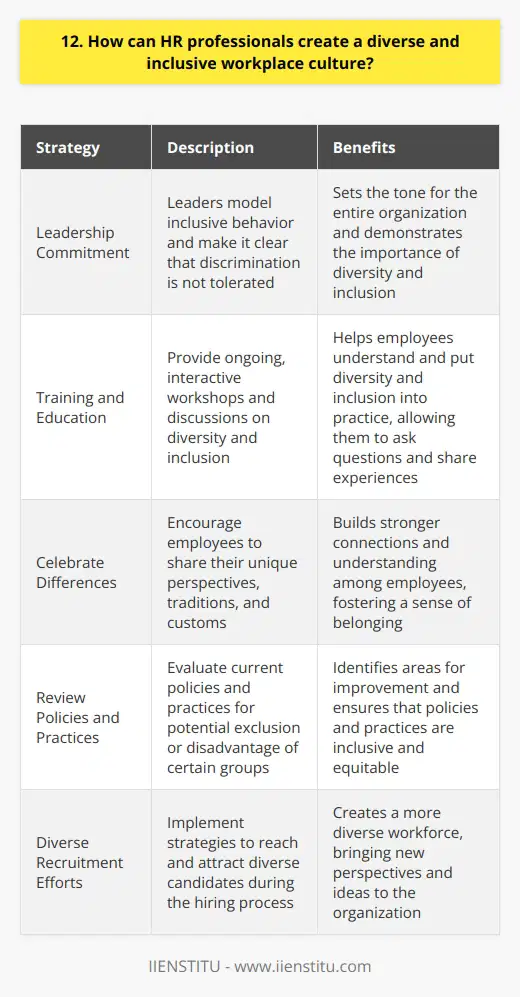
13. What are the key elements of a successful employee onboarding program in the modern workforce?
As a human resources professional with over a decade of experience, I believe that a successful employee onboarding program in the modern workforce should focus on several key elements:
Personalized Approach
Each new hire is unique, so the onboarding process should be tailored to their specific needs and role. This includes setting clear expectations, providing relevant training, and assigning a mentor or buddy to guide them through the initial weeks.
Cultural Immersion
Helping new employees understand and embrace the company's culture, values, and mission is crucial for long-term success. This can be achieved through interactive sessions, team-building activities, and exposure to different departments within the organization.
Technology Integration
In today's digital age, incorporating technology into the onboarding process is essential. This can include online training modules, virtual meetings, and access to digital resources that facilitate learning and collaboration.
Continuous Feedback and Support
Regular check-ins, performance evaluations, and open communication channels are vital for ensuring that new hires feel supported and engaged throughout their onboarding journey. Managers should be proactive in providing feedback, answering questions, and addressing any concerns that arise.
Measurable Goals and Milestones
Setting clear, achievable goals and milestones helps new employees stay motivated and track their progress. This can include project deadlines, skill development targets, and performance benchmarks that align with the company's overall objectives.
By implementing these key elements, companies can create a comprehensive and effective onboarding program that sets new hires up for success and fosters a positive, productive work environment.
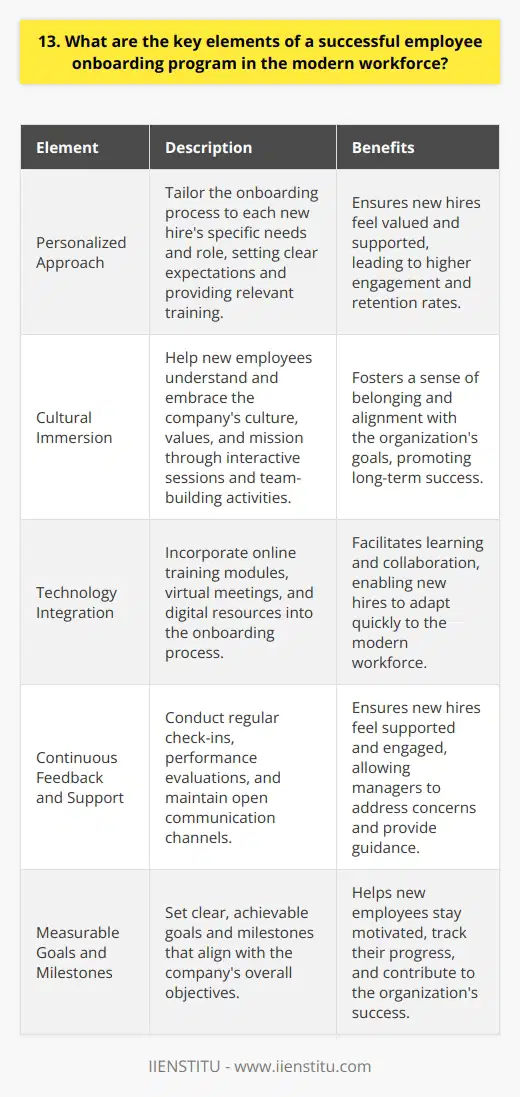
14. How can HR departments support remote and flexible work arrangements while maintaining productivity?
As an HR professional, I believe that supporting remote and flexible work arrangements is crucial for maintaining productivity. In my experience, there are several key strategies that HR departments can implement to ensure a successful transition.
Establish Clear Communication Channels
One of the most important things is to set up clear lines of communication. This means using video conferencing tools, instant messaging platforms, and regular check-ins to keep everyone connected. I've found that having daily or weekly team meetings can help maintain a sense of cohesion and collaboration.
Provide Necessary Resources and Support
Another critical aspect is ensuring that employees have access to the resources they need to work effectively from home. This includes providing equipment like laptops, monitors, and ergonomic furniture, as well as offering technical support and training on remote work tools. In my previous role, we created a comprehensive remote work toolkit that included guides, best practices, and FAQs.
Focus on Results, Not Hours
When it comes to productivity, I believe that it's essential to shift the focus from hours worked to results achieved. This means setting clear goals and expectations, and trusting employees to manage their own time and workload. Personally, I've found that giving my team members autonomy and flexibility has led to increased engagement and better outcomes overall.
Prioritize Employee Well-being
Finally, I think it's crucial for HR departments to prioritize employee well-being in remote and flexible work arrangements. This means encouraging healthy habits like taking breaks, setting boundaries between work and personal life, and offering mental health support resources. In my experience, when employees feel supported and cared for, they're more likely to be productive and engaged in their work.
Overall, I believe that with the right strategies and support, HR departments can successfully navigate the challenges of remote and flexible work arrangements while maintaining productivity and employee satisfaction.
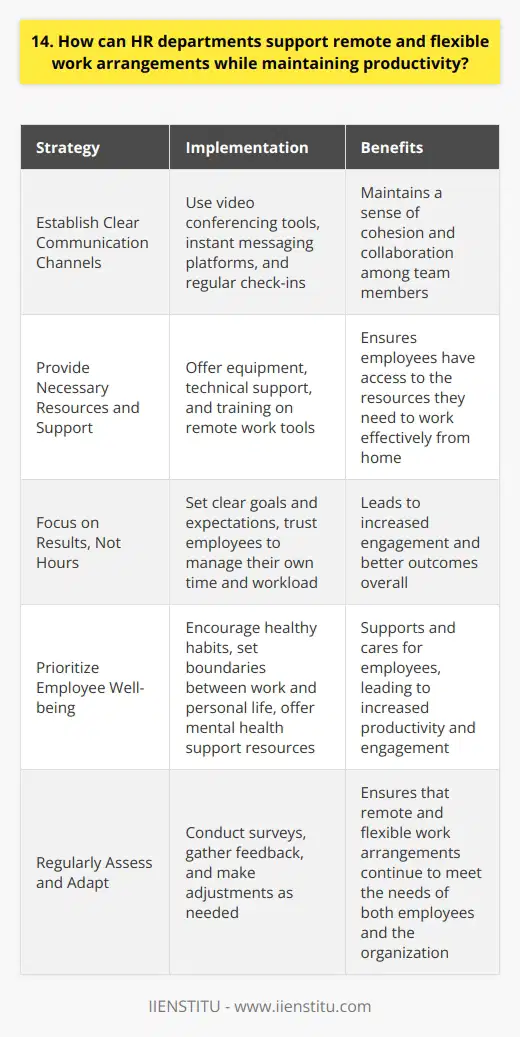
15. What are the best practices for managing and developing a multigenerational workforce?
As a manager, I believe that effectively managing a multigenerational workforce requires a combination of empathy, adaptability, and open communication. Each generation brings unique perspectives, strengths, and challenges to the workplace. To foster a cohesive and productive team, it's essential to understand and appreciate these differences.
Encourage Open Communication
I've found that promoting open and transparent communication is key to bridging generational gaps. Regularly checking in with team members, actively listening to their concerns, and valuing their input creates a sense of inclusivity. Establishing clear channels for feedback and ideas allows everyone to feel heard and respected, regardless of their age or experience level.
Provide Tailored Training and Development
Recognizing that each generation has different learning styles and preferences is crucial for effective training and development. I believe in offering a mix of traditional and modern training methods to cater to various needs. From hands-on workshops to online courses and mentoring programs, providing diverse learning opportunities ensures that everyone can grow and develop their skills in a way that resonates with them.
Foster Cross-Generational Collaboration
Encouraging collaboration across generations is a powerful way to leverage the strengths of a multigenerational workforce. I've seen firsthand how pairing experienced employees with younger team members can lead to incredible results. The older generation can share their industry knowledge and expertise, while the younger generation can bring fresh perspectives and technological savvy. This exchange of ideas and skills creates a dynamic and innovative work environment.
Embrace Flexibility and Work-Life Balance
Different generations often have varying priorities and expectations when it comes to work-life balance. As a manager, I strive to offer flexible work arrangements whenever possible. Whether it's remote work options, flexible schedules, or generous leave policies, acknowledging and accommodating the diverse needs of employees across generations shows that you value their well-being and trust in their ability to deliver results.
Managing a multigenerational workforce is an exciting challenge that requires empathy, adaptability, and a commitment to continuous learning. By fostering open communication, providing tailored development opportunities, encouraging collaboration, and embracing flexibility, managers can create a workplace where employees of all ages feel valued, engaged, and empowered to succeed.
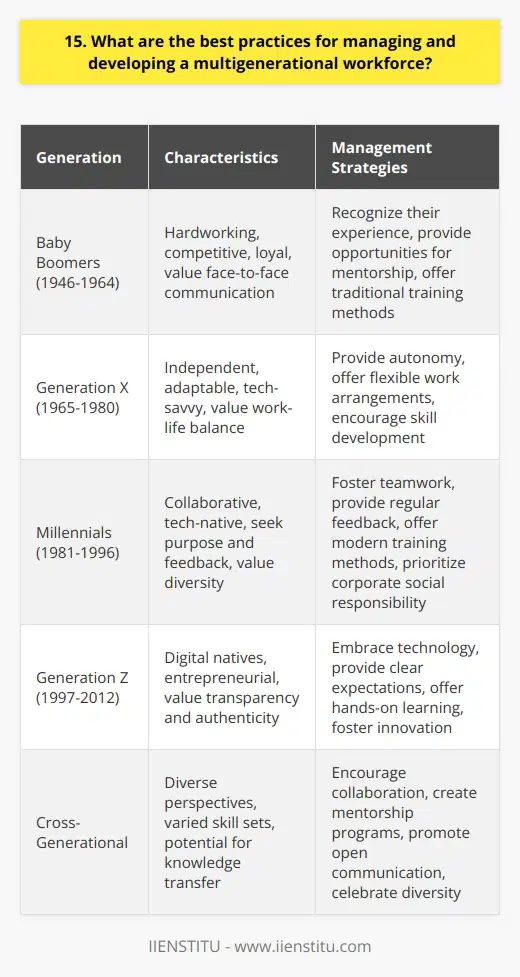
16. How can HR professionals effectively communicate and collaborate with other departments to achieve organizational goals?
As an HR professional, I believe that effective communication and collaboration with other departments are crucial for achieving organizational goals. In my experience, building strong relationships with colleagues across the company has been key to success.
Build Trust and Rapport
I make an effort to get to know people in other departments on a personal level. Grabbing coffee or lunch together helps establish trust and rapport. When you have a foundation of mutual understanding, it's easier to work together productively.
Understand Their Needs and Goals
I always try to put myself in the shoes of my colleagues in other departments. What are their priorities and challenges? By understanding their perspective, I can find ways for HR initiatives to support their goals.
Communicate Clearly and Regularly
Keeping other departments informed about HR programs, policies, and resources is essential. I share updates through various channels - email, presentations, intranet posts, etc. The key is to communicate in a way that's clear, concise, and relevant to their needs.
Seek Input and Feedback
Collaboration is a two-way street. I actively seek input from other departments when developing HR strategies. What do they think about our current programs? What additional support would be helpful? Gathering feedback helps ensure HR is meeting the needs of the entire organization.
Partner on Projects and Initiatives
Some of the most impactful work happens through cross-functional partnerships. I look for opportunities to team up with other departments on projects that support our shared goals. Working side-by-side fosters greater alignment and collaboration.
At the end of the day, HR's mission is to help the organization and its people succeed. By building strong relationships with colleagues across the company, we can develop integrated people strategies that drive results.
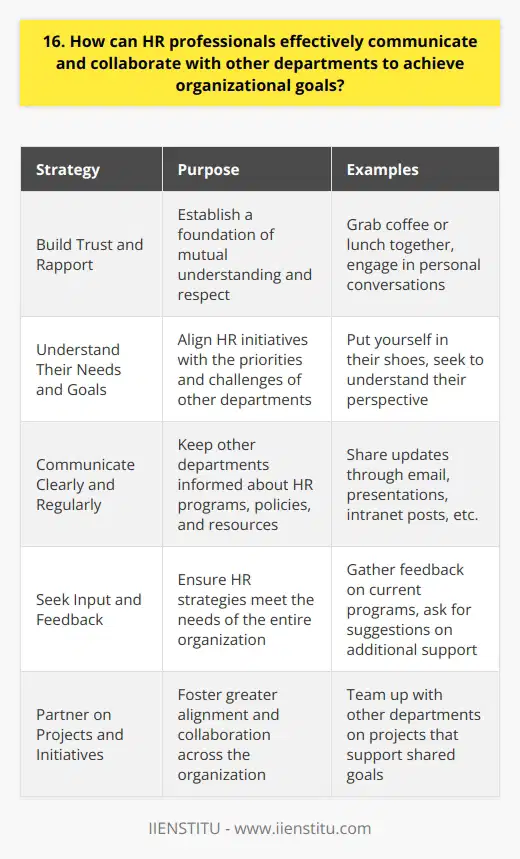
17. What role does HR play in developing and implementing a company's digital transformation strategy?
As an HR professional, I believe that we play a crucial role in shaping and executing a company's digital transformation strategy. Our involvement spans across several key areas:
Aligning Workforce with Digital Goals
We work closely with leadership to understand the digital vision and align talent acquisition and development accordingly. This means identifying skill gaps, recruiting tech-savvy professionals, and upskilling existing employees to meet digital demands.
Fostering a Digital Culture
HR is responsible for creating a culture that embraces digital change. We communicate the benefits of digital transformation, address concerns, and engage employees in the journey. Through workshops, training programs, and change management initiatives, we help build a digitally receptive workforce.
Driving Digital Literacy
To succeed in a digital environment, employees need the right skills and mindset. HR takes the lead in driving digital literacy across the organization. We partner with IT and business teams to deliver targeted training programs that enhance digital competencies.
Supporting Agile Workflows
Digital transformation often involves adopting agile methodologies. HR plays a vital role in supporting this shift by redesigning job roles, performance management systems, and reward structures to align with agile principles. We foster collaboration, autonomy, and continuous learning to drive agility.
Measuring Digital Impact
HR leverages people analytics to measure the impact of digital initiatives on workforce productivity, engagement, and retention. We track key metrics, gather employee feedback, and provide insights to leadership for data-driven decision-making.
In my experience, I've seen firsthand how HR's proactive involvement in digital transformation can make a significant difference. By aligning talent, fostering a digital culture, driving literacy, supporting agile workflows, and measuring impact, we become strategic partners in the company's digital journey.
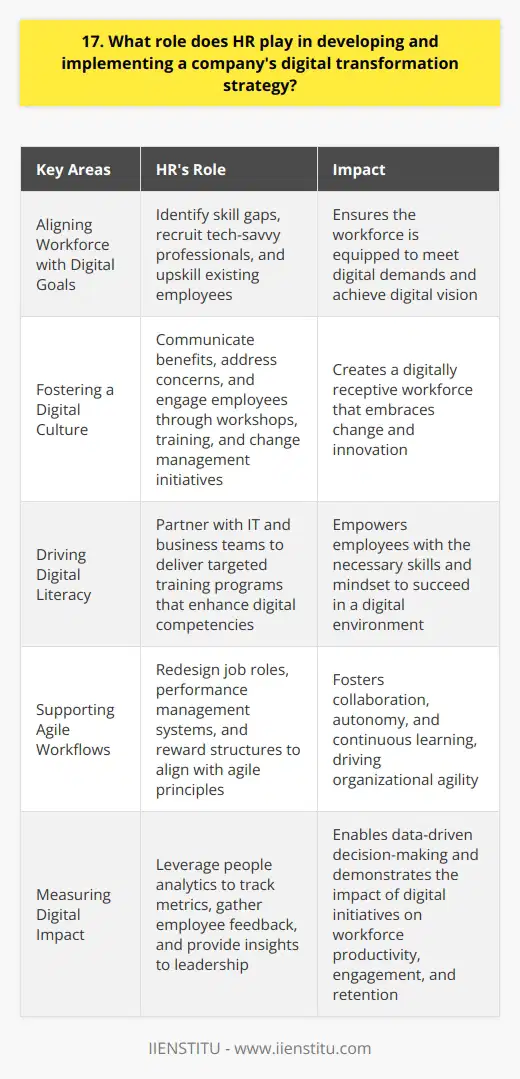
18. How can HR departments create a positive employee experience in the evolving workforce?
As an HR professional, I believe creating a positive employee experience is crucial in today's evolving workforce. It's not just about offering competitive salaries and benefits anymore; it's about fostering a culture of engagement, growth, and well-being.
Prioritize Open Communication
In my experience, employees thrive when they feel heard and valued. HR should encourage regular feedback sessions and create open lines of communication. This helps build trust and ensures employees' concerns are addressed promptly.
Invest in Employee Development
I've seen firsthand how investing in employee growth can boost morale and retention. HR should provide opportunities for skill development, mentorship programs, and career advancement. When employees feel supported in their professional journey, they're more likely to stay engaged and committed.
Foster a Culture of Recognition
Everyone wants to feel appreciated for their hard work. HR can implement recognition programs that celebrate employee achievements and contributions. Whether it's a simple thank-you note or a company-wide award, acknowledging effort goes a long way in creating a positive experience.
Embrace Flexibility and Work-Life Balance
In today's fast-paced world, employees value flexibility more than ever. HR should explore options like remote work, flexible hours, and generous paid time off. When employees have control over their schedules, they're less stressed and more productive.
At the end of the day, creating a positive employee experience is about putting people first. By prioritizing open communication, investing in growth, recognizing achievements, and promoting work-life balance, HR can build a workforce that's engaged, motivated, and loyal.
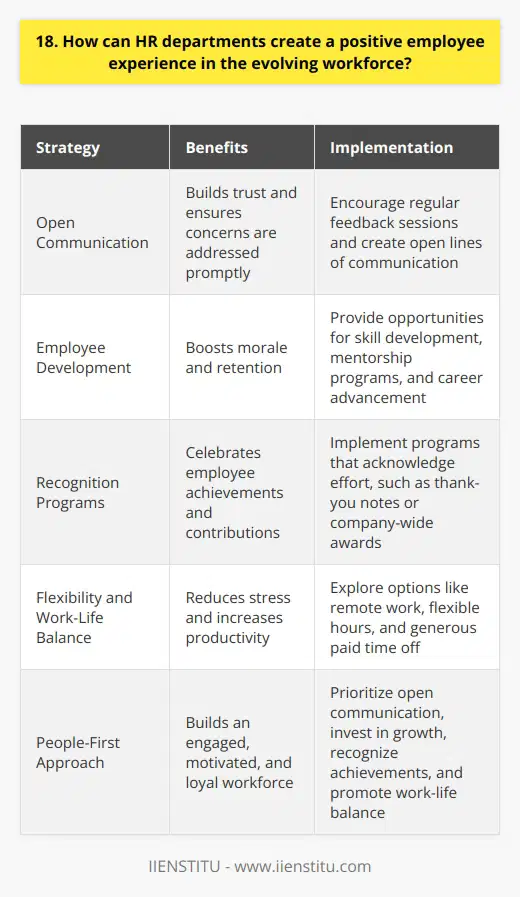
19. What are the most effective ways to identify and develop high-potential employees?
To identify and develop high-potential employees, I believe in a multi-faceted approach. It's not just about raw talent or impressive resumes, but a combination of factors that indicate an employee's ability to grow and contribute to the company's success.
Observing Performance and Work Ethic
I always keep an eye out for employees who consistently deliver high-quality work and demonstrate a strong work ethic. They're the ones who take initiative, go above and beyond their job descriptions, and aren't afraid to take on new challenges. These individuals show a genuine commitment to their roles and the company's goals.
Assessing Learning Agility and Adaptability
In today's fast-paced business environment, adaptability is crucial. High-potential employees are quick learners who can adapt to change and pick up new skills and knowledge with ease. They embrace innovation and are open to new ideas and ways of working.
Fostering a Culture of Growth and Development
To nurture high-potential employees, it's essential to create a culture that values growth and development. This means providing opportunities for learning, such as training programs, mentorship, and stretch assignments. By investing in their development, we show them that we believe in their potential and are committed to helping them reach their full potential.
Encouraging Collaboration and Leadership
High-potential employees often demonstrate strong collaboration and leadership skills. They work well with others, contribute to team success, and inspire their colleagues. Encouraging them to take on leadership roles, even in small ways, can help them develop these skills further and prepare them for future advancement.
Ultimately, identifying and developing high-potential employees requires a proactive and supportive approach. By recognizing their talents, providing growth opportunities, and fostering a positive work environment, we can help these individuals thrive and contribute to the company's long-term success.
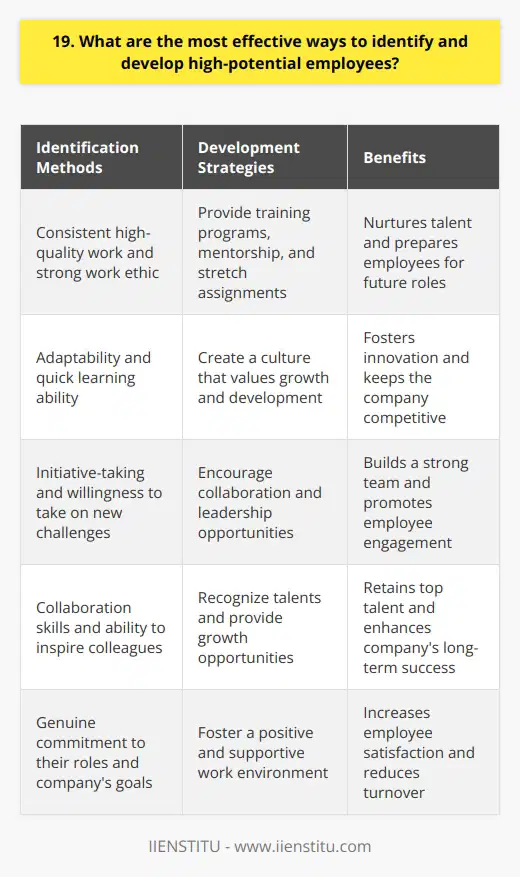
20. How can HR professionals ensure that their organization's learning and development programs align with business objectives?
As an HR professional, I believe that aligning learning and development programs with business objectives is crucial. It ensures that the organization's training efforts are focused on the skills and knowledge that directly contribute to its success.
Understand Business Goals
The first step is to gain a deep understanding of the company's strategic goals and priorities. I would work closely with senior management to identify the key objectives and challenges facing the organization.
Assess Skills Gaps
Next, I would assess the current skills and competencies of the workforce. This helps identify any gaps between the existing capabilities and those required to achieve business goals.
Design Targeted Programs
Based on the identified skills gaps and business objectives, I would design targeted learning and development programs. These programs would focus on building the specific skills and knowledge needed to drive business success.
Collaborate with Departments
I would collaborate with different departments to ensure that the training programs are relevant and applicable to their needs. This involves understanding their unique challenges and tailoring the content accordingly.
Measure and Evaluate
To ensure the effectiveness of the learning and development programs, I would establish clear metrics and evaluation methods. This allows me to measure the impact of the training on employee performance and business outcomes.
Continuous Improvement
I believe in continuously improving the learning and development programs based on feedback and results. I would regularly assess the programs, make necessary adjustments, and stay updated with industry best practices to ensure ongoing alignment with business objectives.
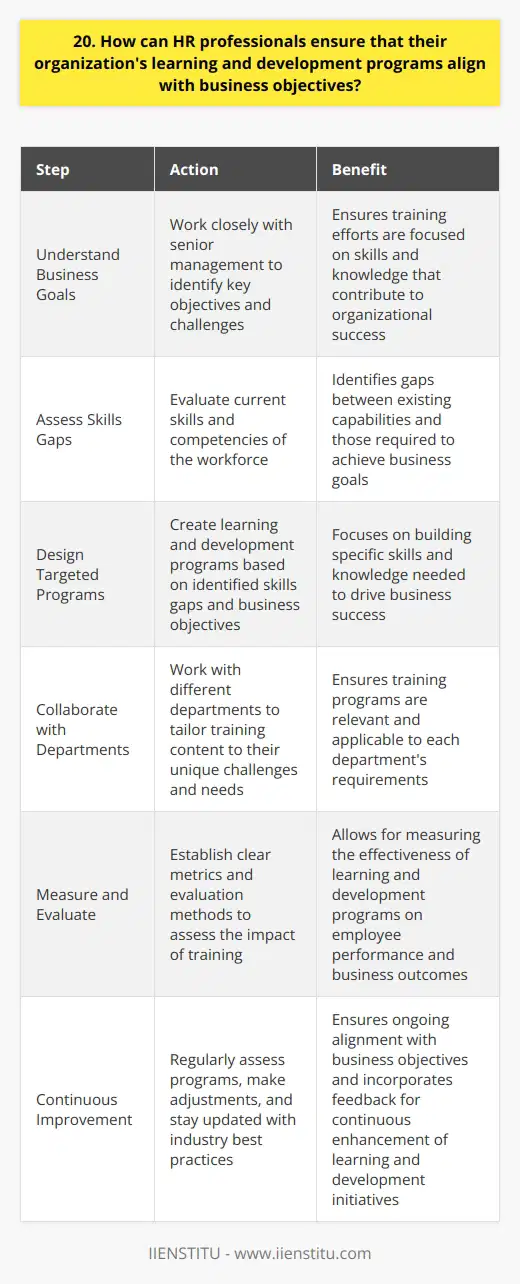
21. What are the key trends shaping the future of Human Resource Development?
As an HR professional, I believe several key trends are shaping the future of Human Resource Development. These trends are driven by technological advancements, changing workforce demographics, and evolving employee expectations.
Embracing Digital Transformation
One of the most significant trends is the rapid adoption of digital technologies in HR processes. From online recruitment to virtual onboarding and training, HR departments are leveraging technology to streamline operations and enhance the employee experience. I've personally witnessed how implementing a cloud-based HR system in my previous organization greatly improved efficiency and accessibility.
Focusing on Employee Well-being and Engagement
Another crucial trend is the increasing emphasis on employee well-being and engagement. Companies are recognizing the importance of creating a positive work environment that supports mental health, work-life balance, and personal growth. I strongly believe that investing in employee well-being leads to higher productivity, reduced turnover, and a more committed workforce. In my current role, we've implemented various wellness initiatives, such as flexible working arrangements and mindfulness workshops, which have received positive feedback from our employees.
Fostering Diversity, Equity, and Inclusion
Diversity, equity, and inclusion (DEI) have become top priorities for organizations worldwide. HR professionals play a vital role in creating inclusive workplaces where everyone feels valued and respected, regardless of their background. I'm proud to be part of an HR team that actively promotes DEI through initiatives like unconscious bias training and mentorship programs. We've seen firsthand how a diverse and inclusive workforce drives innovation and enhances decision-making.
Embracing Continuous Learning and Development
Lastly, the future of HR Development lies in fostering a culture of continuous learning and development. With the rapid pace of change in today's business landscape, employees need to continuously upskill and reskill to remain relevant. HR professionals must design and implement effective learning and development programs that cater to the diverse needs of the workforce. I'm excited about the potential of personalized learning paths and the integration of emerging technologies like virtual reality in training and development.
These are just a few of the key trends shaping the future of HR Development. As an HR professional, I'm committed to staying ahead of these trends and leveraging them to create a more engaged, productive, and fulfilled workforce.
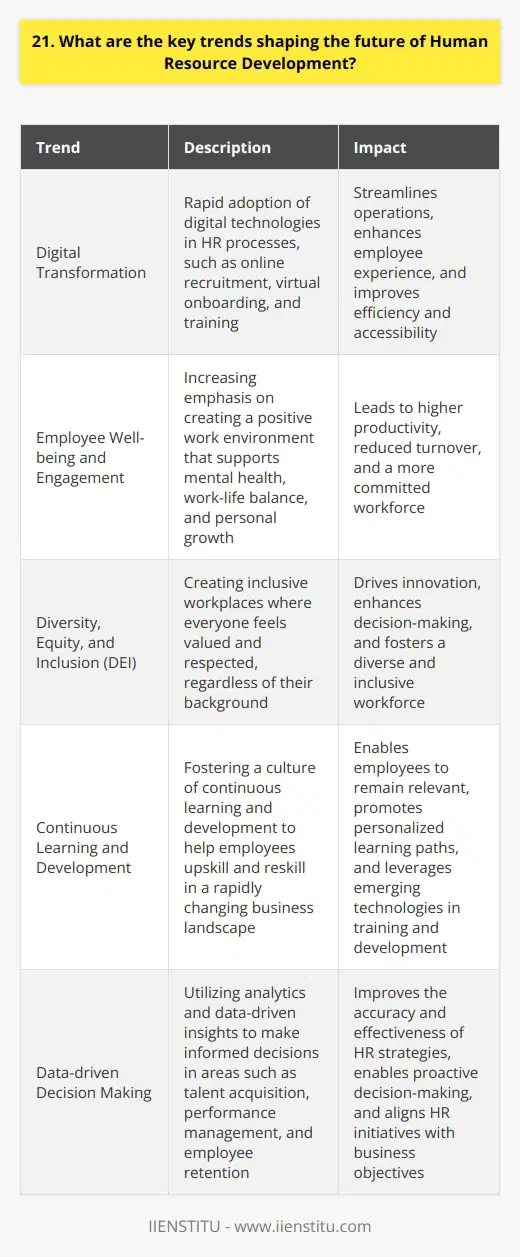
22. How can HR departments support employees' mental health and well-being in the evolving workforce?
As an HR professional, I believe that supporting employees' mental health and well-being is crucial in today's evolving workforce. Here are some ways HR departments can make a positive impact:
Promote Open Communication
Encourage employees to speak openly about their mental health struggles without fear of judgment or repercussions. Create a safe space where they feel heard and supported. In my experience, having regular check-ins with employees has helped build trust and foster a supportive work environment.
Offer Mental Health Resources
Provide access to mental health resources such as counseling services, mindfulness apps, and stress management workshops. Partner with mental health professionals who can offer guidance and support to employees in need. I've seen firsthand how these resources can make a significant difference in employees' lives.
Lead by Example
As HR leaders, it's important to model healthy behaviors and prioritize our own mental well-being. Share personal stories about managing stress, setting boundaries, and practicing self-care. When employees see their leaders taking mental health seriously, they feel more empowered to do the same.
Foster a Positive Work Culture
Create a work environment that values empathy, compassion, and inclusivity. Celebrate employees' achievements, encourage teamwork, and promote a healthy work-life balance. Small gestures like organizing team-building activities or offering flexible work arrangements can go a long way in boosting morale and reducing stress levels.
Remember, investing in employees' mental health is not only the right thing to do but also benefits the organization as a whole. Happy and healthy employees are more productive, engaged, and loyal to their employers.
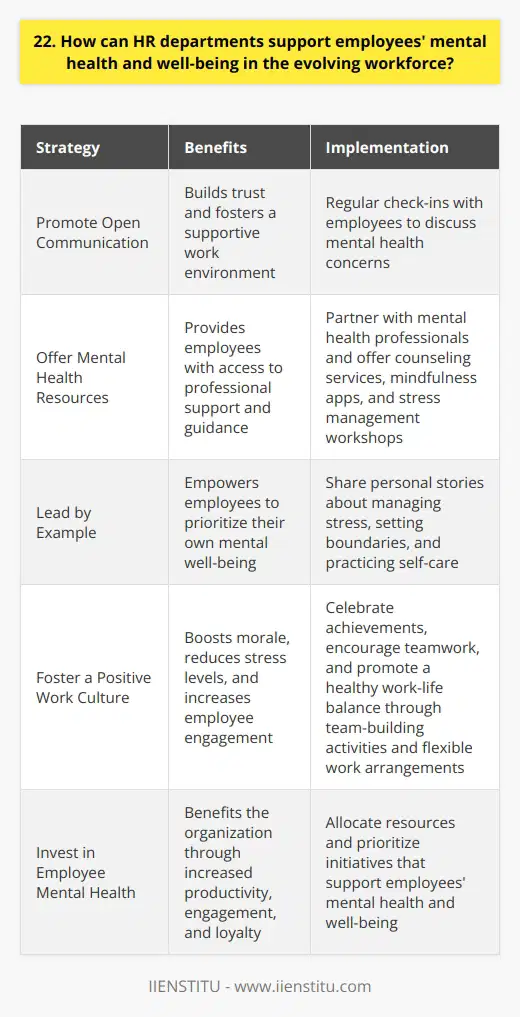
23. What are the most effective ways to measure and improve employee engagement in the modern workplace?
As a manager, I believe that the most effective ways to measure and improve employee engagement involve a combination of strategies.
Regular Check-Ins and Feedback Sessions
I've found that scheduling frequent one-on-one meetings with team members helps foster open communication. These sessions provide opportunities for employees to share their thoughts, concerns, and ideas in a safe space. By actively listening and addressing their needs, managers can build trust and rapport, leading to higher engagement levels.
Conducting Employee Surveys
Implementing anonymous employee surveys can offer valuable insights into the overall sentiment within the organization. These surveys should cover topics such as job satisfaction, work-life balance, and perceived support from management. Analyzing the results helps identify areas for improvement and guides targeted initiatives to boost engagement.
Recognizing and Rewarding Achievements
In my experience, acknowledging and celebrating employee successes goes a long way in promoting engagement. Whether it's through public recognition, bonuses, or personalized rewards, showing appreciation for hard work and dedication motivates employees to go above and beyond. It reinforces the idea that their contributions are valued and integral to the company's success.
Providing Growth and Development Opportunities
Investing in employee growth and development is crucial for maintaining engagement. Offering training programs, mentorship opportunities, and clear career paths demonstrates a commitment to their professional advancement. When employees feel supported in their growth, they are more likely to be engaged and loyal to the organization.
Ultimately, improving employee engagement requires a proactive and empathetic approach from management. By fostering a culture of open communication, recognition, and growth, companies can create an environment where employees feel valued, motivated, and truly engaged in their work.
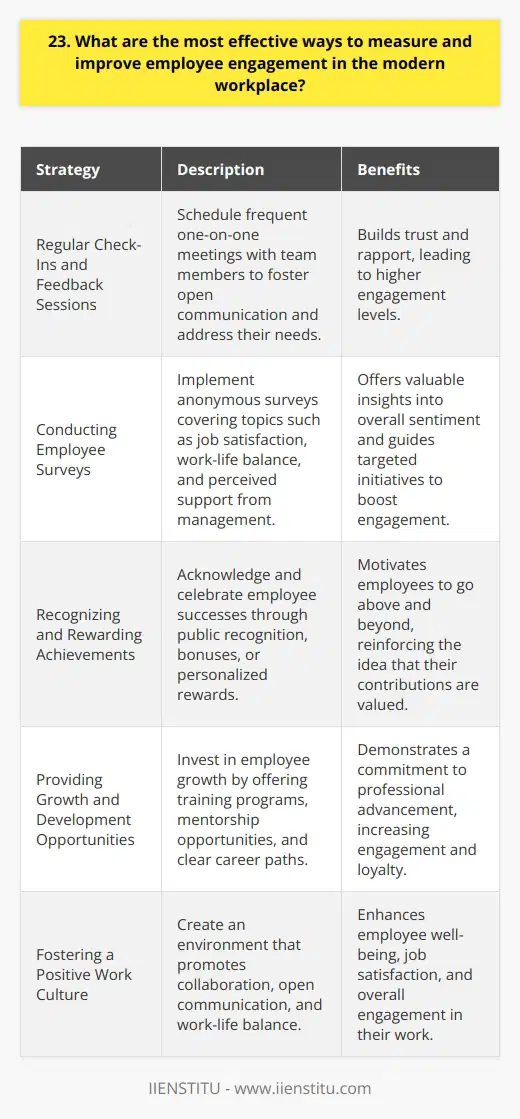
24. How can HR professionals develop and implement successful succession planning strategies?
As an HR professional, I've found that developing a strong succession planning strategy is crucial for long-term organizational success. It's not just about filling positions; it's about ensuring a smooth transition and continuity of leadership.
Identify Key Positions and Potential Successors
The first step is to identify the critical roles that drive your company's success. These are the positions that would be most disruptive if left vacant. Then, look for high-performing employees who demonstrate the skills and leadership potential to step into these roles in the future.
Develop and Nurture Talent
Once you've identified potential successors, invest in their development. Provide training, mentoring, and stretch assignments that will prepare them for future leadership roles. I remember one employee who we identified as a future leader; we sent her to a leadership development program and gave her the opportunity to lead a cross-functional project. She thrived and was ready to step up when the time came.
Create a Culture of Leadership Development
Succession planning shouldn't be a one-time event; it should be part of your company's culture. Encourage managers to have regular career discussions with their team members and to identify and develop future leaders. When everyone is invested in growing talent, it creates a pipeline of ready successors.
Plan for the Unexpected
While we hope that our succession plans will unfold smoothly, life can be unpredictable. That's why it's important to have a plan B (and even a plan C) for critical roles. Cross-train employees and develop a deep bench of talent so that you're prepared for the unexpected.
Communicate and Implement the Plan
Finally, ensure that your succession plan is clearly communicated and implemented across the organization. Everyone should understand their role in the process and be committed to its success. Regular check-ins and updates will help keep the plan on track.
Developing a robust succession planning strategy takes time, effort, and commitment, but it's one of the most important investments an HR professional can make in their organization's future success.

25. What are the best practices for creating and managing a global workforce?
When creating and managing a global workforce, communication is key. Establish clear channels for sharing information across different time zones and cultures. This helps ensure everyone is on the same page and working towards common goals.
Embrace Cultural Diversity
I've found that celebrating the unique perspectives and experiences each team member brings can lead to incredible innovation. Encourage open-mindedness and provide cultural sensitivity training to foster a respectful, inclusive environment. Some of my best ideas have come from collaborating with colleagues from totally different backgrounds.
Invest in the Right Tools
To keep a global team connected and productive, you need reliable tools. I'm a big fan of video conferencing for face-to-face meetings and cloud-based project management software to coordinate tasks. Just be sure to choose user-friendly platforms and provide ample training. There's nothing more frustrating than tech hiccups derailing your workflow!
Prioritize Employee Well-Being
Working across borders can be challenging, so it's crucial to support your team's physical and mental health. Offer flexible schedules when possible, encourage breaks, and check in regularly. I'll never forget how supported I felt when my manager noticed I was burning out and insisted I take some time off. That compassion made me even more motivated to do my best work.
At the end of the day, successfully managing a global workforce comes down to valuing your people. With open communication, cultural empathy, the right tools, and a commitment to well-being, you can build a thriving international team. The diverse talents and viewpoints are well worth the effort!
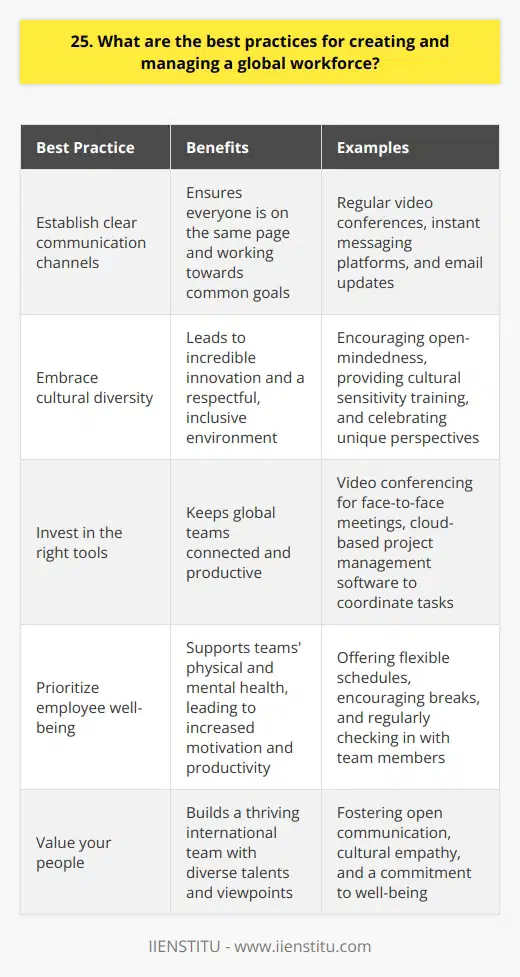
26. How can HR departments leverage social media and other digital platforms for recruitment and employer branding?
HR departments can leverage social media and digital platforms to enhance their recruitment and employer branding efforts. Here are some strategies they can employ:
Utilize Social Media Channels
HR should actively use platforms like LinkedIn, Facebook, and Twitter to post job openings and engage with potential candidates. By maintaining a strong presence on these channels, they can attract top talent and showcase their company culture.
Share Employee Stories
Highlighting employee experiences and success stories on social media can give candidates a glimpse into the organization's culture. I remember reading an inspiring post about how a company supported an employee's personal growth, which left a lasting impression on me.
Collaborate with Influencers
Partnering with industry influencers can help HR reach a wider audience and establish the company as a thought leader. When I came across a webinar featuring a well-known expert and a company representative, it piqued my interest in the organization.
Engage in Relevant Conversations
HR should participate in online discussions related to their industry and share valuable insights. By actively contributing to conversations, they can attract potential candidates who are passionate about the field.
Leverage Employee Advocacy
Encouraging employees to share their positive experiences on social media can be a powerful way to enhance employer branding. Seeing genuine employee testimonials can influence a candidate's perception of the company and make them more likely to apply.
By implementing these strategies, HR departments can effectively use social media and digital platforms to attract top talent and build a strong employer brand. It's an approach that I believe can yield significant results in today's competitive job market.

27. What role does HR play in fostering innovation and creativity within the organization?
HR plays a crucial role in fostering innovation and creativity within an organization. They are responsible for creating a work environment that encourages employees to think outside the box and come up with new ideas.
Encouraging Collaboration
HR can promote collaboration by organizing cross-functional teams and facilitating communication between departments. When employees from different backgrounds and skill sets work together, they can generate unique solutions to problems.
I once worked on a project where HR brought together people from marketing, engineering, and customer service. By combining our diverse perspectives, we came up with a game-changing product feature that boosted sales.
Providing Resources and Training
HR can support innovation by providing employees with the resources and training they need to develop new skills. This could include access to online courses, workshops, or mentorship programs.
When I was learning to code, my company's HR department connected me with a senior developer who became my mentor. His guidance and support were invaluable in helping me grow as a programmer.
Recognizing and Rewarding Innovation
HR can encourage employees to be innovative by recognizing and rewarding their efforts. This could include bonuses, promotions, or public acknowledgement of their achievements.
I remember feeling incredibly proud when HR featured my team's project in the company newsletter. It motivated us to keep pushing ourselves and thinking creatively.
Fostering a Culture of Experimentation
Finally, HR can foster a culture of experimentation by creating a safe space for employees to take risks and try new things. This means embracing failure as a learning opportunity and encouraging employees to keep iterating and improving.
In my experience, the most innovative companies are the ones that aren't afraid to fail. They understand that progress often requires taking bold risks and learning from mistakes along the way.
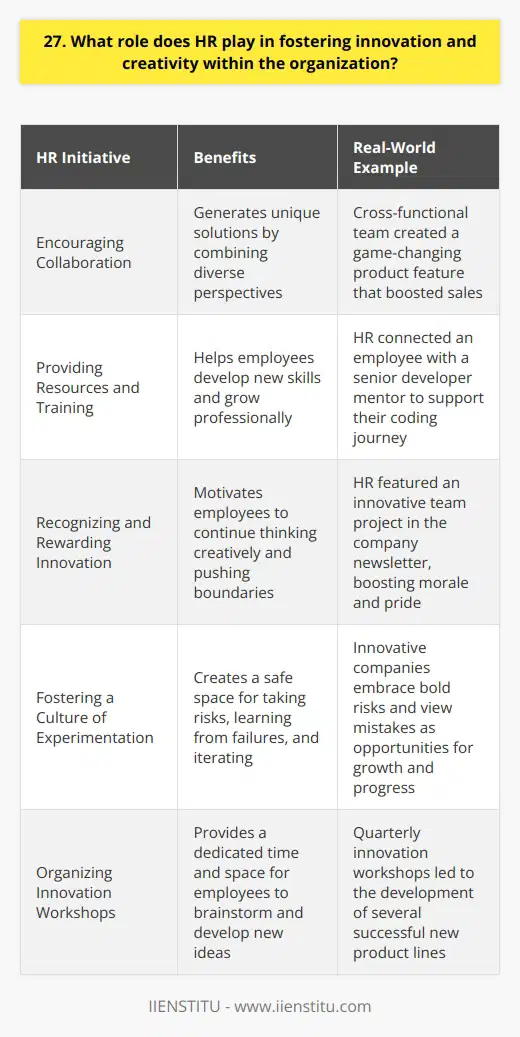
28. How can HR professionals effectively manage and resolve conflicts in the evolving workforce?
As an HR professional, I believe effective conflict management in the evolving workforce requires a proactive and empathetic approach. It's essential to create a safe space for open communication, where employees feel heard and valued.
Active Listening and Impartiality
When conflicts arise, I make sure to actively listen to all parties involved without judgment or bias. By maintaining impartiality, I can gain a clear understanding of the situation from multiple perspectives.
Identifying Root Causes
Once I've gathered all the information, I work on identifying the root causes of the conflict. Often, underlying issues like miscommunication, differing expectations, or personality clashes contribute to workplace tensions.
Facilitating Open Dialogue
I facilitate open and honest conversations between the conflicting parties in a neutral setting. By encouraging them to express their concerns and feelings, we can begin to find common ground and build understanding.
Collaborative Problem-Solving
Together, we brainstorm potential solutions that address everyone's needs and interests. I guide the discussion towards win-win outcomes, ensuring all parties feel heard and respected throughout the process.
Implementing Agreements and Follow-Up
Once a resolution is reached, I help develop clear agreements and action plans. Regular follow-up meetings ensure that the agreed-upon solutions are implemented effectively and that any new concerns are promptly addressed.
By approaching conflict resolution with empathy, impartiality, and a focus on collaboration, HR professionals can foster a positive and productive work environment in today's diverse and evolving workforce.
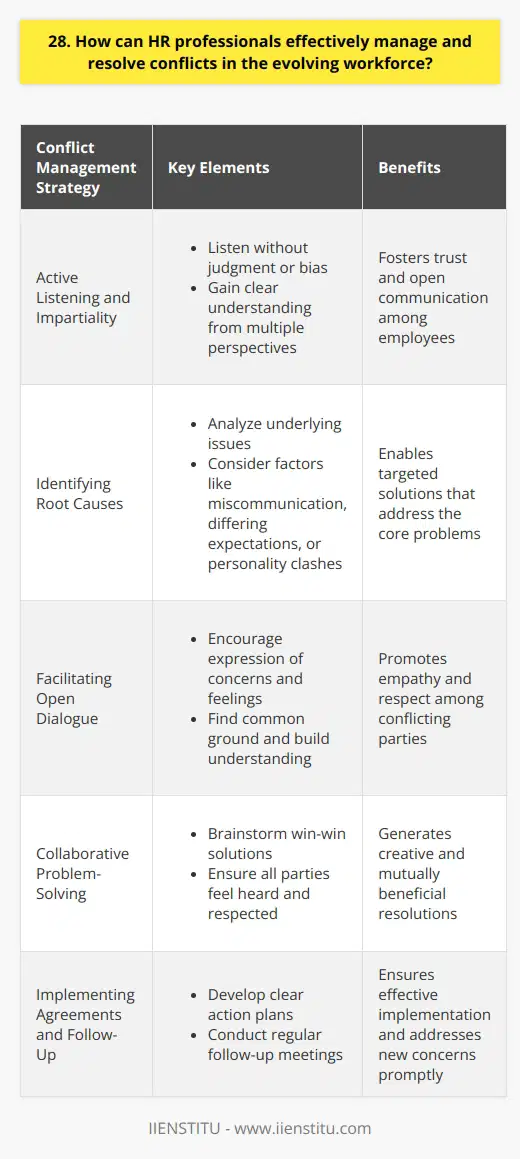
29. What are the most important considerations for HR when implementing a performance management system?
When implementing a performance management system, HR must consider several critical factors. First and foremost, the system should align with the company's overall strategy and goals. This ensures that employee performance contributes to organizational success.
Fairness and Consistency
The performance management system must be fair and consistent across all employees. HR should establish clear criteria for evaluating performance and apply them uniformly. Managers should receive training to minimize bias and subjectivity in their assessments.
Employee Engagement
Engaging employees in the performance management process is crucial. HR should communicate the system's purpose and benefits clearly. Employees should have opportunities to provide input and feedback throughout the process. When workers feel invested, they're more likely to embrace the system.
Regular Feedback
Performance management shouldn't be a once-a-year event. HR should encourage regular feedback between managers and employees. Frequent check-ins allow for course corrections, support, and recognition. Ongoing dialogue fosters growth and improvement.
Development Opportunities
A strong performance management system identifies areas for employee development. HR should work with managers to create individualized development plans. Offering training, mentoring, and stretch assignments helps employees acquire new skills and advance their careers. When people see a path forward, they're more engaged and motivated.
In my experience, a well-designed performance management system is a powerful tool. It aligns individual efforts with company objectives, supports employee growth, and drives business results. By considering these key factors, HR can create a system that benefits both employees and the organization.
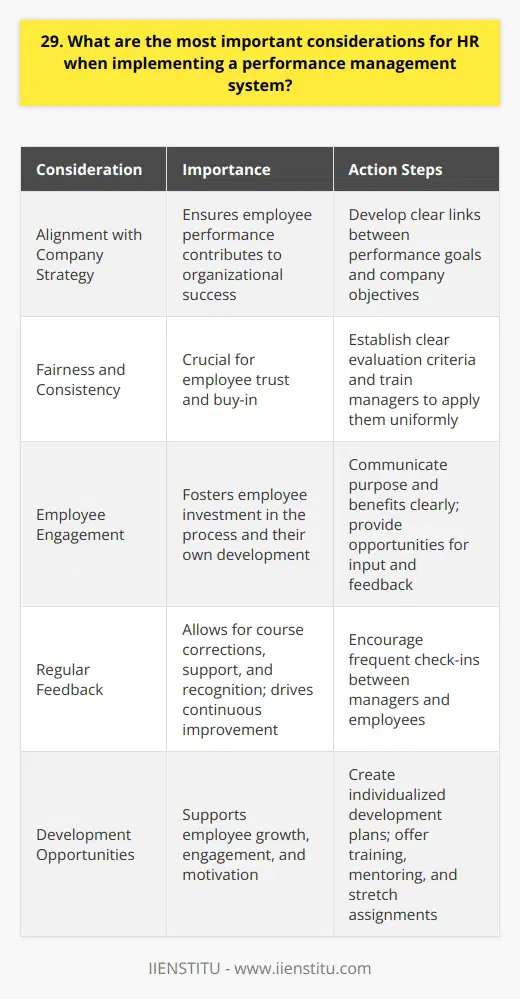
30. How can HR departments create a strong leadership pipeline to ensure long-term organizational success?
HR departments play a crucial role in creating a strong leadership pipeline for long-term organizational success. They should identify high-potential employees and provide them with targeted development opportunities.
Assess Leadership Potential
HR should regularly assess employees' leadership potential through performance evaluations, 360-degree feedback, and behavioral interviews. They should look for individuals who demonstrate strong communication skills, emotional intelligence, and a growth mindset.
Provide Targeted Development Opportunities
Once high-potential employees are identified, HR should offer them targeted development opportunities. This could include leadership training programs, mentoring, and stretch assignments that challenge them to grow.
I remember when I was working at my previous company, HR implemented a leadership development program. They selected a group of high-potential employees, including myself, to participate in a six-month program.
We attended workshops on topics like effective communication, delegation, and strategic thinking. We also had the opportunity to work on cross-functional projects and receive mentoring from senior leaders.
Foster a Culture of Leadership Development
HR should foster a culture of leadership development throughout the organization. They should encourage managers to provide ongoing feedback and coaching to their direct reports.
Additionally, HR can create opportunities for employees to take on leadership roles, such as leading a project team or mentoring a new hire. By providing these opportunities, HR can help employees develop their leadership skills in a safe and supportive environment.
Succession Planning
Finally, HR should have a robust succession planning process in place. They should identify key positions within the organization and develop a pipeline of talented individuals who can step into those roles when needed.
By taking a proactive approach to leadership development, HR can ensure that the organization has a strong pipeline of leaders who are ready to take on new challenges and drive the business forward.
